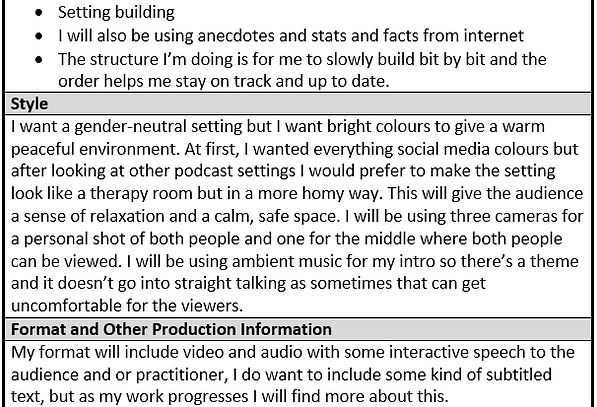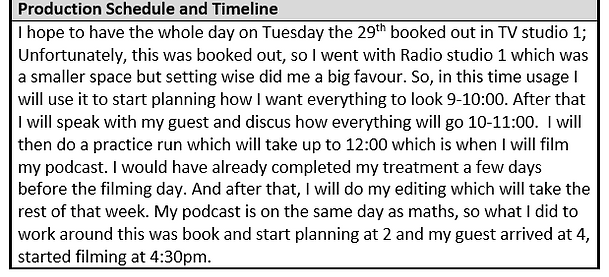
Target audience
My target audience:
Someone who's suffered or struggling with their mental health. This is one of the main reasons people would want to watch my podcast, because my goal is to help young kids and adults with their mental health; someone who does struggles will open up to watching a this will catch their eye because they will be able to relate. For my project this is helpful to keep in mind as because a lot of my audience will suffer with their mental health, I will have to remind myself to keep at a certain maturity level and remain calm. Remaining calm and professional is key for my project because a lot of people with mental health issues will radiate off the mood of my podcast, and making sure my audience is calm and comfortable at all times throughout the video. How I will do this is by talking slowly so that I'm more clear and so I can have time to think before I say something, I will make sure to research other podcasters language to see how they hold up their professionalism.
Another target audience approach would be someone who wants a role model to listen to their mental health and understand them; this is crucial because a lot of people who suffer with mental health feels as though they don't feel heard or understood, this is important to me because I have felt this way, and it's the reason I started this journey, so making sure my audience feels welcome and understood is so crucial for me because when someone feels understood they will feel easier about opening up and will continue to keep coming back and watching more content.
Another reference for watching my podcast would be if someone has been affected by social media, or if they know someone that's had issues on the apps. Because my podcast is to help others stay safe online, this means that people that missed that chance to learn before can understand now and get a sense of relief or use the podcast as an educational purpose, which is great for marketing because people who want to protect their mental health if it isn't bad already; which means I will get a range of views from people who care about the education and scientific evidence that's being embedded in my project.
For another target audience persona would be for someone who's spends all day on their phone and social media; maybe they don't like doing this but they cant stop. This type of audience will get a lot out of my podcast because I will speak about the harm social media does to people and hopefully it can be an insight to show people the truth and make them more weary in future in case something bad were to happen. This way I can build a foundation base loyalty with the audience so they can trust me and come back to learn more. This is also important for me because I can tell who's interested in scientific evidence or who's more interested in the mental safe side. Because I'm going to remain sensitive and calm for those watching because of mental health, but also remain professional and formal for the people watching because of the social media scientific background evidence. And to make sure I cover over both these topics I will be evaluating and drafting how I'm going to do something and what I'm going to do. This way I can check over everything and make sure its all okay and professional.
Someone interested in the science behind social media is also a great type of audience as I will be discovering all about this and sharing. Although there are other podcasters, people would watch me, because, I will be connecting with the audience and my main focus is giving the audience what they want. I will focus on emotion and safety which a lot of other influencers may not think about. This type of target audience will be beneficial for my podcast as I can get feedback on the science I spoke about; and also, they will help create a wider base of audience because its not just mental health. And not just about people who struggle, it's about people who want to learn or enjoy learning new things.
A bit about target audiences
Everyone has psychographics and demographics, so when I think about my target audience I would break it down into these sections. Psychographics are how someone would feel or interact; I like to think of it as what makes that person different from others when you get to know them. Whereas demographics, are more with what to can see on a person and what makes them stand out without knowing their personality.
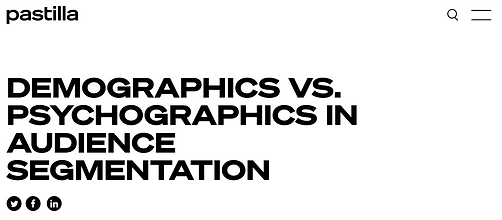
Psychographics Demographics
Personality characteristics
For instance, someone's beliefs, values, opinions and how your audience would interact with the project. It's important to remember this as you can connect with your audience on a more meaningful level and understand fully what they would interpret from your work.
Interests
Interests are important because they allow you to understand how ones emotions would react to your content based on their likes and dislikes, Interests would include, what other content they like, what subject topics catch their eye etc..
Behaviour
Behaviour habits are important because you can begin to recognise the patterns in which people will watch certain things. An example would be someone watching a group of videos all around the same length long, 20 minuets; so their behaviour occurrents would be short length video.
Age
Age is important to my topic because I will be focusing on adolescence and young adults mental health when social media is involved. My audience's target age is 15-26, which means I have to study into the younger generations psychographics. This will be beneficial to my work as I can try to interpret what they would want to gain and achieve from my project; so I will imitate that to create a piece of media for my target audience.
Gender
For my project, I mostly focus on both genders as everyone struggles with this not just a certain gender; because I will focus on both genders, I need to do my primary research to work out what genders are more affected and speak about why this is the case or speak about what I can do to focus more onto either side.
Ethnicity
Ethnicity isn't that big of an issue with my research as the persons racial background doesn't tie into my work unless it was revolved around bullying/ racial crime; so for that case I will speak up on it but as someone that hasn't personally delt with these issues it would be hard for me to comment on that.
Family status
For my project, this includes how many people in your home and how your home life is. The way you react and socialize with others in the same home situation as you can feel comforting but also can be quite patronising after a period of time.
income
Income can tie into how much they would want to spend on the website or viewing apps; because a lot of media forms include payment. I will have to consider this in the future when my projects will encounter a selling point.
I used this website to help with the mind map interpretation and what the different definitions and factors are.
Buyer Persona - detailed profiles representing idea customer based on demographic behaviour and preferences.
demographics - statistics that describe populations and their characteristics. Demographic analysis is the study of a population-based on factors such as age, race, and sex.
psychographics - the study of personality, values, opinions, attitudes, interests, and lifestyles.
Buyer Persona
For my buyer persona I had to think of an audience's demographics and psychographics to create a personality that matches someone who would be interested in my podcast and benefit my website.
In my last project I did 4 buyer persona's. Here.
But because I'm doing more to this project, I used inspiration from my previous one and created some new buyer persona's for my project.
Buyer persona
Demographics
Name: Emma
16 years old.
Female.
Lives at home – upper working class.
White British.
Psychographics
Hates school.
Has Instagram, snapchat, TikTok and twitter.
Doesn’t have a diagnosed mental illness but would describe her mental health as quite poor.
Her hobbies used to be playing sports but now she states she hasn’t got any hobbies.
Goes to a public school with an attendance of 86%.
She stays at home and hardly sees friends and family.
More about her:
Emma would go to school and mostly be on her phone in class; her teachers would always be picking on her and sending her out for this. Emma said she hated school and wish she could be homeschooled forever. When Emma is at home, she’s usually doing makeup or scrolling through social media. Emma said she’s never struggled with bullying on social media but because a lot of her friends and followers, she feels as though she must always look and act perfect; she states this is a horrible feeling. Emma would like to understand why she feels this way and what is really hurting her mental health. That’s why my podcast is so productive for her as I will be covering how harmful social media is and why it acts this way.
Buyer persona 2
Demographics
name: Jenna
19 years old.
Female.
Lives alone - minimum wage – university.
White British.
Psychographics
Enjoys Uni.
Studying art.
Has Instagram, Facebook, snapchat, TikTok and twitter.
Diagnosed with ASD. Says this affected her whole school experience and make her mental health poor.
Her hobby is painting.
More about her:
Jenna is diagnosed with Autism, and she explains how this has affected all her childhood and explains she never fitted in. She explains how she would go onto social media and always feel pressured to post but too scared as she “doesn’t look the same as these other girls,” Jenna felt like this was affecting her anxiety and she wishes social media was never created. Jenna always tries her hardest not to think about it but every time she would go onto social media, mainly Instagram she would get this overwhelming anxiety that haunts her whenever she had to leave the house.
Target Audience Types - beneficial for my project
Struggles or has struggled with mental health.
Wants to have a role model, or someone on social media who understands.
Social media has affected them, or someone they know.
Spends all day on social media - maybe doesn't want to be like this.
wants to have a role model, or someone on social media who understands
Interested in social medias harm in a scientific way.
Addicted to social media and has mental health issues.
Wants to find out why social media is so bad and what we need to do to stop it.
Is young, or has young kids and wants to understand if social media is worth it.
Interested in learning about social media and or mental health.
These are my target audience because, anyone interested in these topics will find something interesting and helpful. Or they would enjoy the content I post and will want to watch more. This way I can connect with my audience so they keep coming back; furthermore because of my project type I would catch a lot of peoples attention to create a bigger wider audience of people, so more people can receive that help and information.
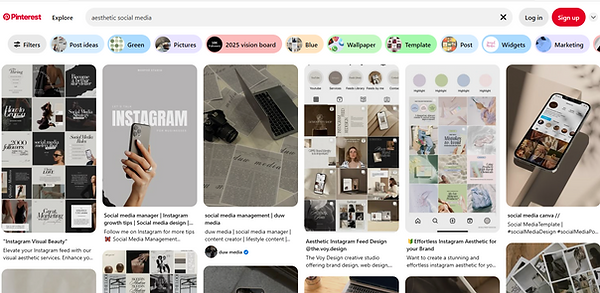
My Edits
When choosing my photos I concluded the idea that only certain photos could match. I had to think about what photos scream the project idea. I needed to include photos that matched the theme but also aren't too "scary", what I mean by this, is because I'm doing mental health I have to watch what I post in case it could offend anyone or in case its too harmful.
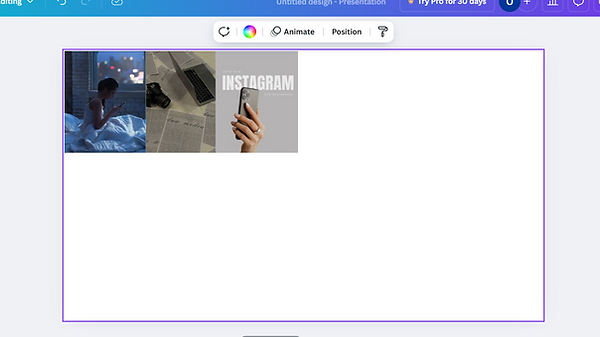
I started off by asking a classmate how they did their mood board as mine aren’t that good. He told me to use Canva and gave me a small tutorial on how to produce the best mood board possible. I started off going on Pinterest and google by looking up the titles “aesthetic social media” this is in order to get some photos to do with social media but in a more pleasant looking approach. I found lots of photos but not all of them stood out to me. A lot of photos on Pinterest had a whole board of photos, this was extremely annoying because I didn’t want to use other people’s mood boards, I wanted to create my own. After searching more on Pinterest I decided to move onto google, where I found more singular photos that highlighted what I was looking for. I also used the topics “mental health aesthetic” but this mostly came up of lots of posters and bright colours. This unfortunately wasn’t the aesthetic I was going for. After adding the photos I wanted I realised it didn’t look good with different colours and shades, so I hopped back onto Pinterest and types in “social media aesthetic grey” and “mental health aesthetic grey” this time I had more photos that were suitable for what I was going for and they colour grey was best fitting as it produces a type of atmosphere that anyone can like. It sets a neutral colour so I can build on with different colours without looking like a mess because there’s too much colour everywhere. Grey also indicates its gender neutral so I’m not cancelling anyone out.
TO LOOK AT THE PHOTOS THAT I ADDED TO MAKE MY MOOD BOARD PLEASE CLICK...
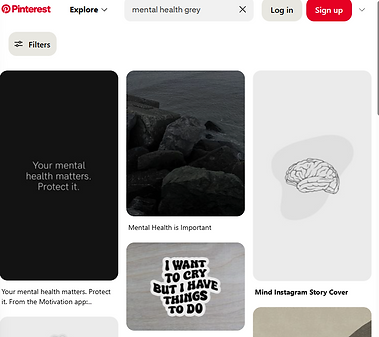
I started off by adding photos that fitted my theme, as I got more involved in my photos I decided grey was the best colour code for my mood board. When it started off being coloured I didn't like how how it looked, I didn't like how it looked messy and all over the place. So to neat it out I changed each photos shade to match the grey theme, when I had to choose the shades; I looked at each grey shade to see which one looked better and what one blends better with the rest of the photos. Overall I'm really impressed and happy with how everything turned out. I think the photos match well, it gives an overview of what to expect in my work and it all correlates well, even though they're not all the same shade grey, it still matches well.
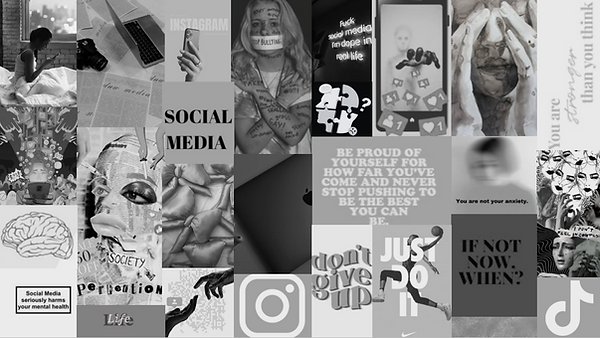

When uploading the mood board to my website, I used it on my home page to have a bit of imagery to the page. I decided to put it on my home page because that's the page you will see first; therefore having the imagery mood board on the front was the best idea because it gives the viewer an insight to what to expect and because its the first thing you see it can reminisce with people and they will remember it.
For the title font, at first I wasn't sure what font I should pick but after looking through I decided this one fitted best. It was called Playfair Display Bold. I used this one in particular because it gives the calligraphy effect of looking cursive, but not too cursive where it looks girly or like a social media post. I made every first starter letter for every word a capital to pronounce the first letter of each word a capital because it creates a clean, bold, and balanced look. which makes the title name stand out and feel more structured and professional.
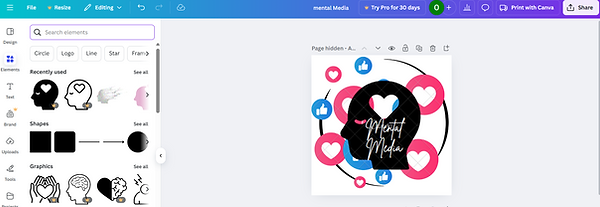

For the text and the menu I chose the font Junge, I did this because this font is formal but its also easy to read and looks very presentable. When thinking of my audience, this font is perfect; because lots of young people will like the aesthetic look of this font and it also wont look like too much writing all over the place as this font levels out the visual effect and makes it more suitable for younger people to read.
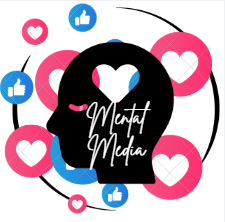
I started off by going on Canva to think of a logo design. I found this circle template and thought that was a good border to have. After finding this I decided to look at some others in case there were better ones; but I couldn't find any that matched as well as the previous one. After I chose to include the circle boarder I searched up, in the image search bar, social media, then I had lots of different images that surrounded social media; such as phones, like button images, thumbs up images and emojis. I was looking through and found this one with hearts and thumbs up. I really liked the look of this and I was incredible pleased with the colours that was chosen. Furthermore, I added that to my circle boarder and continued my search to include something to do with Mental health. I again, typed in mental health into the search bar to find something. All that came up were hearts or brains or a human face. A lot of these images were colourful and or black and white. I knew I didnt want colour as I chose the social media image for the colour. I wanted a black border of a hukman head with nothing around it so you could see all the designs in the back. Eventually, I did find this black sillioete of a head with a heart for the brain. I thought this image corrolated incredibly well in my topic because you can cleatrly see thatthere will be something to do with the mind = menatl health and sociasl media. I was happy with how my overall logo turned out.

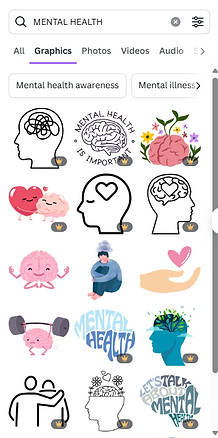
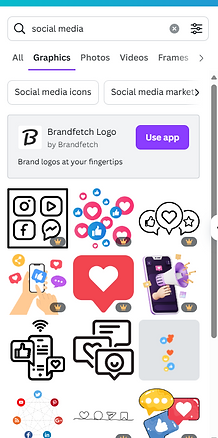
Here is my first interpretation of what I wanted to achieve and do in this project. I spoke about a summery of what I did in the previous years, I spoke about why I chose certain things and why this would be helpful in my work and helpful for the audience. I put this here to deteramin how I wanted the overall project to look like at the final result; but, I included this mainly to see what I've changed or how this still makes me feel thoughout the project.
My research Mind maps
* I put podcast in bold to acknowledge the fact that this mind map is about my podcast not my wix website.
Before I moved onto research and the next steps, I decided to do some mind maps. I chose to do this because mind maps are so useful to me and I can work extremely well when using them productively. When I have a mind map, I can look back and add to whenever I need. Another reason why mind maps are helpful to me is because I wont be able to lose them. When its written on paper its easier to read and easier to understand. I like to use mind maps as a topic starter, so here I've noted down anything that I need to talk about or need to remember for the project. I did 5 mind maps about: target audience, this is important because I need to be able to understand who's watching this video and to keep in mind what they would want to gain out of my work. What I'm promoting and I also have to keep in mind about attention span and who's mostly targeted and what would they say think or do that correlates to my work. The second topic I'm doing is on the Editing, style and structure, this is because I wanted to note down everything I want the overview of my podcast to be like or what I wanted to include/ make sure of. The third mind map is about my research plan, for this I wrote down all the topic subheadings ( what research I want to include) and then underneath I explained what I will be researching for that certain topic. This is to help me know what it is I need to research about and add to my Wix website. The forth mind map I did was about how I can find people, this was about how I was going to find a guest to do my podcast. Overall this is helpful to make notes so I can keep going back to find new ways if these don't work, and see what I could try next. My last and final mind map is on contextual research, personally I never understood this to the full extent. So what I made notes of was to do with looking at a overall subheading that includes why I need to research this and topics to research. Because of me not understanding the contextual research, making this mind map helped me to think of what I needed to research for this. Example because in case I made that unclear, I didn't understand what contextual research was, so on teams there was a list of what's covered in contextual research, so what I did was create a list under those topics of what I need to research and what its about so hopefully by doing this I can understand what it means and create good contextual research.
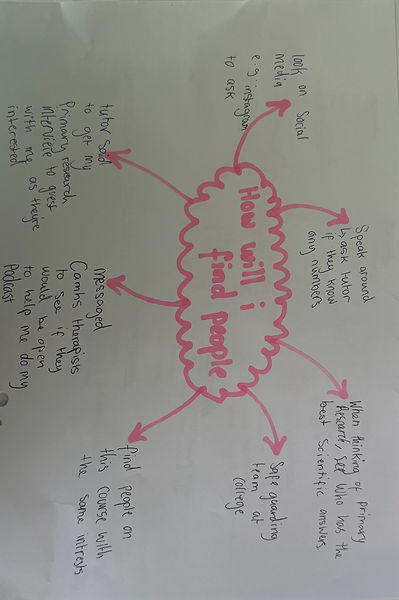_edited.jpg)
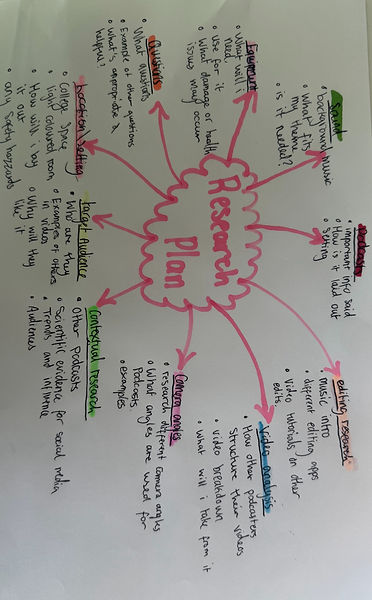_edited.jpg)
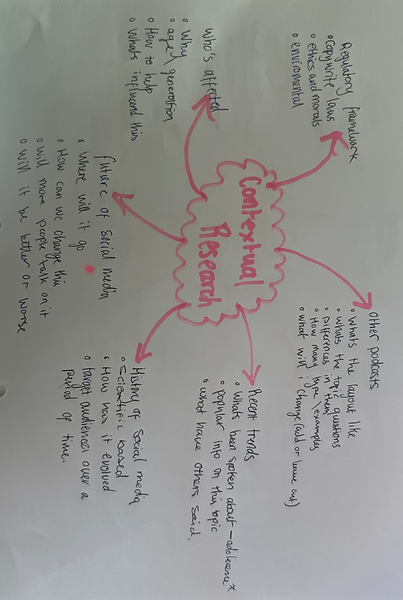_edited.png)
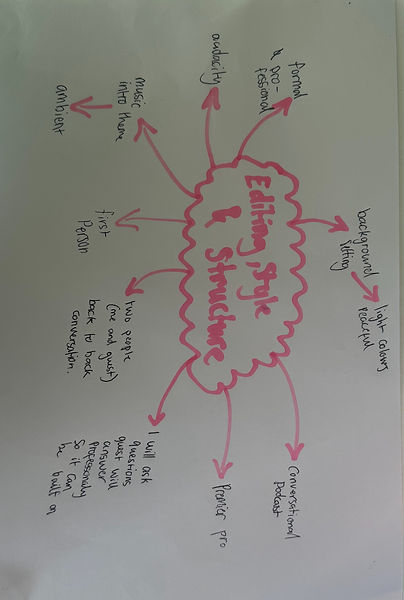_edited.jpg)
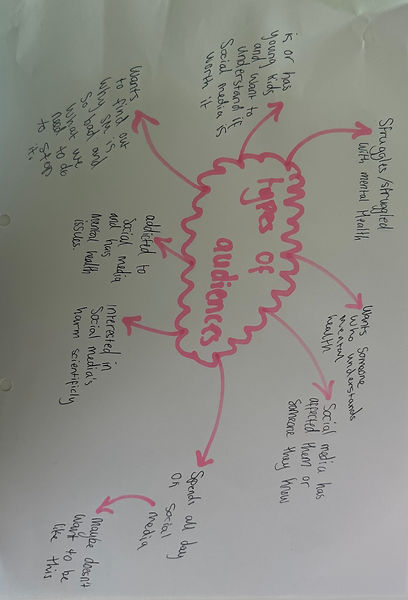_edited.jpg)
Target audiences
My target audience is something that is extremely important. As I need to understand my audience to create a piece of media that my audience will gain from. I want my audience to feel understood, to also relate, to learn from and to take something away from it. Because this topic means a lot to me and its something I care about deeply, I understand what its like to search for this sign of hope and because of the struggles I've faced I can connect with the audience that feels this way. When creating the audience I had to think of what kind of persons demographic and psychographics that would openly be interested in this or a shape of form with mental health. My main goal is to help people; I have to remain formal and professional and by understanding who my audience are I can create that language barrier.
Editing, style and structure
Research plan
How will I find people?
Contextual research
When it comes to editing; this is one of my challenges I will face through this project. I want to research into editing styles and maybe watch some editing tutorials on YouTube. In college we mainly use premier pro and audacity for editing, so I will most likely stick with them. When it comes to the style; I spoke about what I would like the overall look of my podcast to be. This includes of; the type of music I want to add, how I want the setting and layout of my room to be and the type of format I want to include throughout my filming. For structure, I thought about how I would want the conversations set out. In what order and I chose to go with conversational questions to build on. I spoke about what language types I will use and to answer why, that would be purely from the fact that my podcast needs to be formal and serious so people wont take it as a joke, and they can connect better with the information given.
Here I have written about my research plan. I did this to help me understand what I need to research about and the important topics I cant forget about. All of these topics are important because under them have bullet points of what I need to focus on; for my project I came to the conclusion that sound, podcasts, editing, video analysis, camera angles, contextual research, target audience, location/setting, questions and equipment are the things I need to focus on for my topic. All these topics of research will help me understand everything I need to think about in order to get a full idea set in place of how I want my podcast to look; this will also be helpful to show others how I got to my podcast and what steps were being taken.
In this mind map I wrote down how I am going to find people/ a guest for my podcast. This was important for me as this had to be the most important part. I needed to give myself some backup options in case something doesn't go to plan. This is beneficial so that others can see where the ideas for my guest came about. My first option would be someone from the DBT CAMHS team but if that cant happen I will use someone else for backup. I was a little unsure what to write as I did stress a little over it, but I feel as though I concluded the best plans set in place for me to work out any other options if need be. Now I've got my mind map its so much easier to create another plan if something doesn't go right.
I didn't understand contextual research at all; so what I did was put my topic questions based on contextual research and under did bullet points of the things I need to look up and write about. This is helpful as it breaks down the steps I need to do and also gives me a more clear understanding of what contextual research is. This is helpful to evaluate what went well and what didn't, what I now understand or still don't understand.
Primary research
I'm going to start off by doing a survey and post it over Instagram, my college and on teams. I stuck around lots of QR codes over the college and during my 2 week break I will continue to put them around Swanage town. Another piece of primary research I will be doing will include another person, my phone for recording and some questions. For this form of research I will be interviewing a few people to get an idea of how they feel when speaking about social media. I will come up with some questions that relate to my topic.
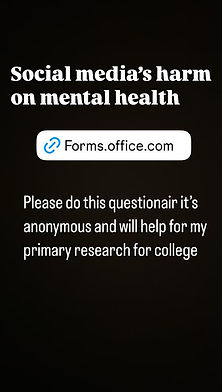
I created a link on Instagram and made a story so other people can give their opinions. I also used Instagram because I know more people would view it meaning I have a higher chance of getting more views and comments.
Here I posted my survey to teams for my class to fill out. This is helpful because that's what the majority of people in my class do. This is also a good way to get feedback or give people more time for them to answer. Unfortunately for me, I'm not as "popular" so not many of my classmates would show interest or make it a priority when they have their own work to do.
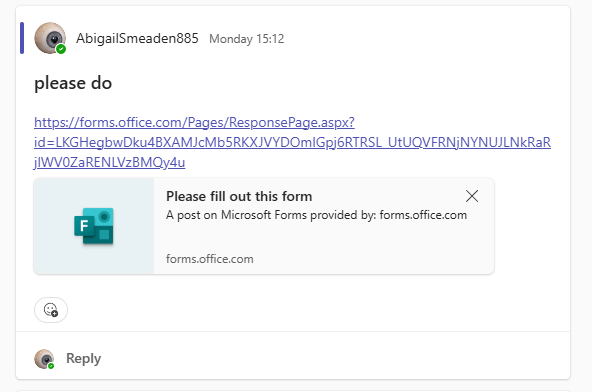
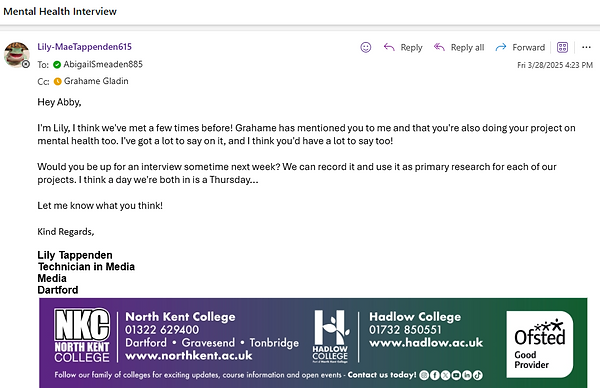
I arranged to create an interview with Lilly, who also speaks a lot on mental health. This is helpful for my primary research because I can get a conversation between two people who care a lot on this topic but also from another perspective this is helpful so I can get more ideas and more information about social media from someone in my age barrier. For my podcast, this will help me create more questions or topic starters as I will have insight from my target audience base.
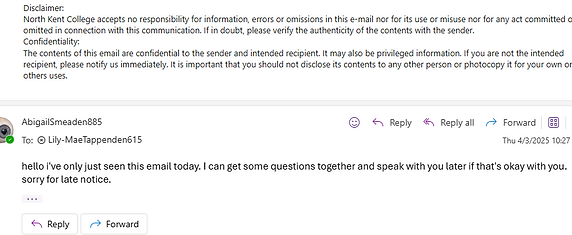
I also have an interview booked with Aisha who has struggled with her mental health. She is also in my target audience range, this will be helpful to my podcast as I can get more experienced answers by someone who's struggled and for this one-to-one conversation can give me more knowledge on other experiences of what she would do in this situation and how her mental health has affected her view on social media.
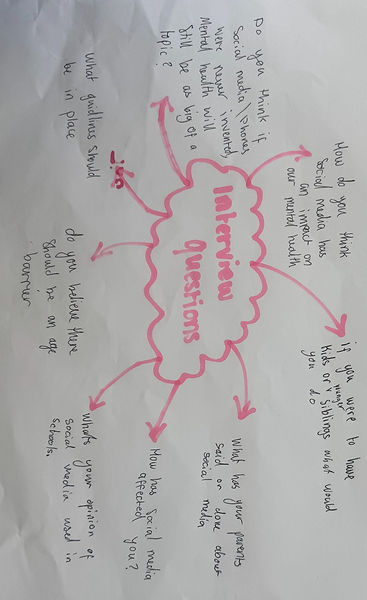_edited.jpg)
Here are the questions for my interview. I had some help from Grahame to think of what questions. The reason I asked Grahame for help is because I didn't want the same questions as my survey because they're more yes or no questions and also they're not really a question you can build on. Or properly find out how they feel about this topic or how its affected them. So Grahame helped me think of a few questions that go in depth about how they would feel or what they think should be done. The questions are:
-
If you were to have kids, or younger siblings, what would you do? (to protect their mental health on social media)
-
what has/ have your parents said or done anything about social media?
-
how has social media affected you?
-
what's your opinion on social media being used in school or by school kids?
-
do you believe there should be an age barrier?
-
what guidelines should be put in place?
-
do you think if social media/ phones were never invented, would mental health still be as big of a topic as it is today?
-
how do you think social media has an impact on our mental health?
Primary research - interviews
These Interview started off by asking my first Question "if you were to have kids, or younger siblings, what would you do to protect their mental health?" I asked this question because I wanted an opinion of the other person if they were in a situation of seeing this in someone they love. People don't look or care about a situation unless it's pointed on them. The next question is "What has/ have your parents said or done anything about social media" This question is important to my project as I want to find information on what they believe the older generation will do or has done. The next question is "how has social media affected you" this is good and bad but it's also helpful information as this way I can get a different input of how people feel. I know how I feel but I want to know more when it comes to my target audience. The next question is "what's your opinion on social media being used in school or by school kids." By asking this I can get an outsiders perspective on what they feel schools should be doing for the up coming younger generations. I also asked the question "do you believe there should be an age barrier" I asked this because I want to understand if other people have an opinion on how old someone should be to have social media. This is important to my project because I want to understand what my target audience may think so I can interpretate those ideas into my production. The next question is about "what guidelines should be put in place" for this I want to understand what others/ my target audience would want to have in place to protect them, therefore in my podcast I can speak and reflect on that. The next question is "do you think if social media/ phones were never invented, would mental health still be as big of topic as it is today" I asked this because I wanted to understand how someone who struggles with mental health feels about this; as a lot of people on my survey wouldn't be as involved or understanding. I know this because 13% of people on my survey said mental health has never affected them. The last question is "how do you think social media has an impact on your/ our mental health." This question I wanted to understand what they think is the reason to this link in further detail so that for my project I can understand a little more on where other peoples opinions are when it comes to these issues and what the cause is.
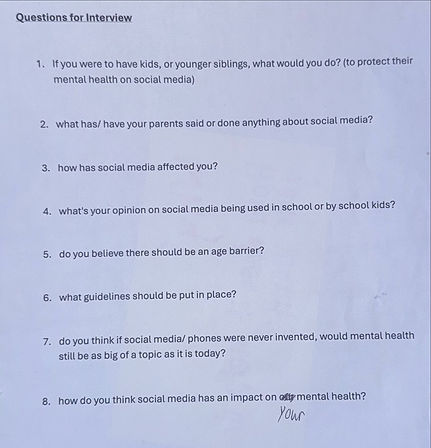.jpeg)
Primary research - survey
When thinking of my questions for my survey, I went onto word and chose these six questions. For my last question, I wasn't sure on what I could ask; but with help from my tutor, and we thought of a great question idea that I was highly exemplary with.
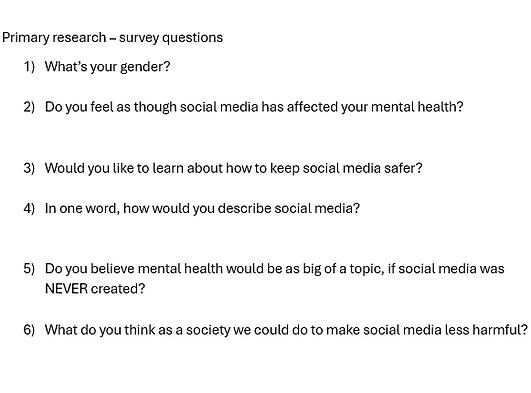
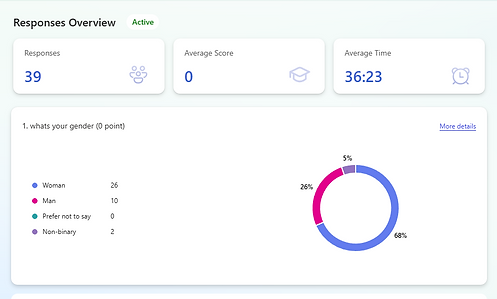
This was my first question, this will help me decide which gender is more affected by social media. I got a total of 26 women and 10 men, I also got 2 non-binary. No one voted prefer not to say.
Q1
For this question, I wanted to ask about the gender, because my idea is focused on both genders, I wanted to ask this questions to get an insight to who is more affected and who cares more. Idealising the genders is a great way for me to determine who's more at risk. I also see lots of stats online that focus on who's affected more so I can decide if the stats online are of the same level as my stats.
Q2
For this question, I wanted to see how many people are affected by this topic, and because I asked that previous question I can discover if there is more men or woman who are affected by social media.
Q3
For this question, I wanted to ask if people are actually curious about keeping social media safer. I want to find this out because that is what I want people to get out of my podcast; so understanding who would actually be interested because if there is lots of yes's then i will acknowledge to keep that in mind when filming my podcast.
Q4
For this question, I wanted to ask about one word that would explain mental health to people, this is so helpful because I can really understand peoples opinions in a short answer. For my previous project I asked a question similar but not one word; and even though this was helpful my answers were paragraphs and it was more difficult to understand peoples true meaning, so this time I put one word so it can be quick and simple.
Q5
For this question, I was diving into how other people think, because for me, I do believe social media is a big cause but I want to see what other people, that don't think about this often would think. Getting more opinions is helpful for me to conclude the idea that other people also agree to make this change
Q6
For this question, my tutor helped me create the idea, a big important thing to ask people is what they would do to change this harm. And that's what this question is aiming towards. This question will help me in my work to create a sense of what us as a society/ target audience would like to do/ change to make social media better. Before, in my previous project I asked if banning social media will help, and because most people said no, I decided to build on this and ask a more universal question of what would YOU change.
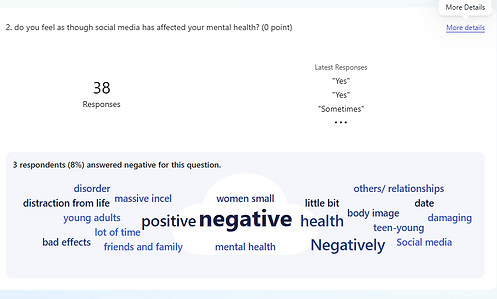
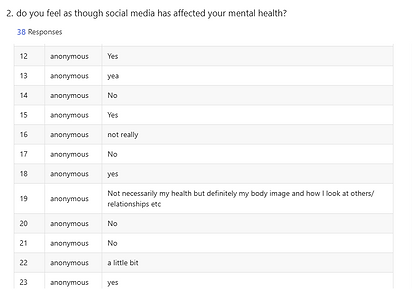
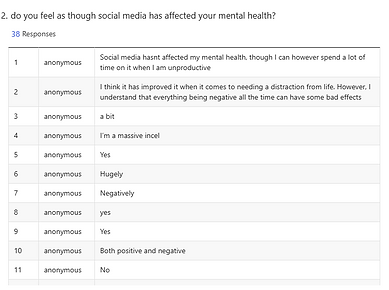
The second question was to write your own answer. The question is do you feel as though social media has affected your mental health. This is very controversial as I worked out 13 people said no, 25 said yes. Overall this can tell me that the majority of teenagers do suffer with social media harms. There was some answers that weren't sure or some said it affected them in other areas but I counted that as yes, if something is making you feel bad, its making your mental health poor meaning it does affect you. This will help my project because I am getting an insight to what's going on in other peoples head. It also clears up my points.
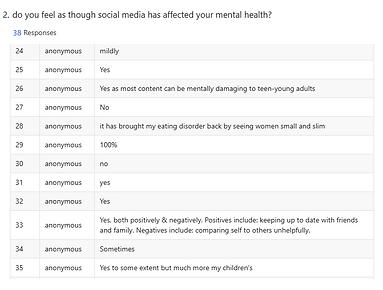

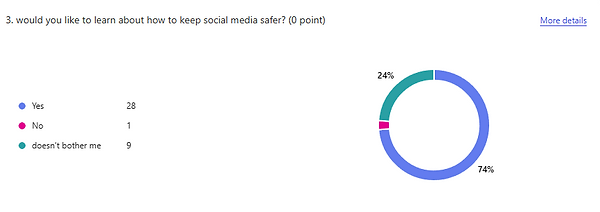
This question is about understanding if others want to learn about social media harm; 28 people said yes they would, 1 person said no, and 9 people said it didn't bother them. Overall I can see that most people do want to learn about these harms but also some people don't think about it enough to let it bother them. This is helpful to my project because I can understand that its important to others that want to be safe. My aim is to share ideas to others to be safe, so seeing that most people would love to learn then it's proven that my project is helpful to others and my audience.
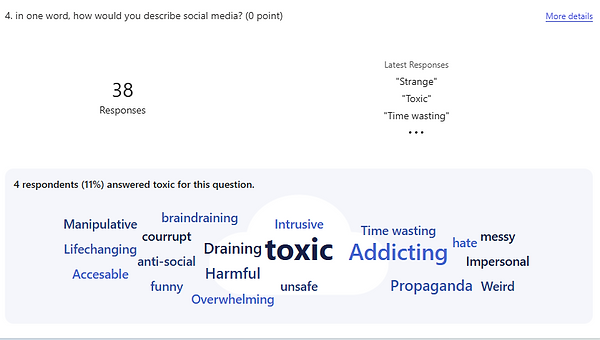
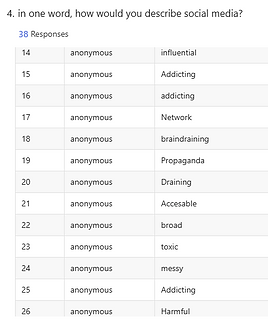
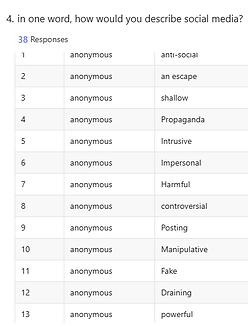
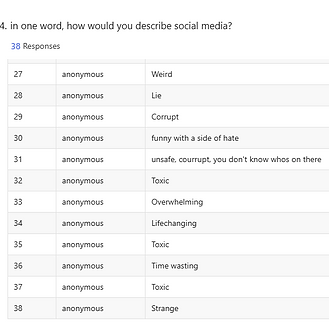
Question 4 was to get information on how others would view social media, firstly, I didn't mention the idea of it being bad or good I just asked their opinions. Already, we can tell a lot of people would announce this as toxic, this is because 11% of people all had the same answers. Moving onto what everyone has said. Here's all the answers I got : Anti-social, An escape, Shallow, Propaganda, Intrusive, Impersonal, Harmful, Controversial, Posting, Manipulative, Fake, Draining, Powerful, Influential, Addicting, Addicting, Network, Brain draining, Propaganda, Draining, Accessible, Broad, Toxic, Messy, Addicting, Harmful, Weird, Lie, Corrupt, Funny with a side of hate, Unsafe, corrupt, you don't know who's on there, Toxic, Overwhelming, Life-changing, Toxic, Time-wasting, Toxic, Strange. All of these are the objectives that would describe social media; are all somewhat harmful, if you was to describe a person as these everyone would steer far away from them. This is all crucial to my project as I can understand real opinions of my target audience and real life ideas of what others may be feeling. This also highlights how no one would think of these apps as safe and fun, they're all something you would be afraid of. I asked for one word because I wanted to get to the main issue which to be described in one word is easier to acknowledge how someone feels. I'm sure a lot of my audience feel this was so keeping this in mind I can work out what to keep my focus on in order for people to get the quality and ideas/ information they're looking for.

Question 5 is a multiple choice question asking if people believe mental health would still be as big as it is today if social media never came around. I asked this because I want to understand where other peoples ideas are of this. I did my research into it so I know but I wanted another set of ideas. 9 people stated it would be which is helpful to understand another set of views.. next time I will make a statement under that asking why as I'm not sure where peoples ideas are. 22 people said no, this was most common because social media is the reason we find so much out about others, this is helpful because it proves my point of belief and lets my audience understand that social media is a big part of mental health. 7 people stated they weren't sure, this is fair because not many people care about this or don't use social media. I think another question I should have asked would have been do you have social media? Next time I will think of that. This is helpful to my project as I get another set of opinions on something I also agree with; this also tells me a bit about what my audience will believe which helps me develop y research into what topics to focus on and what my target audience will hope to see
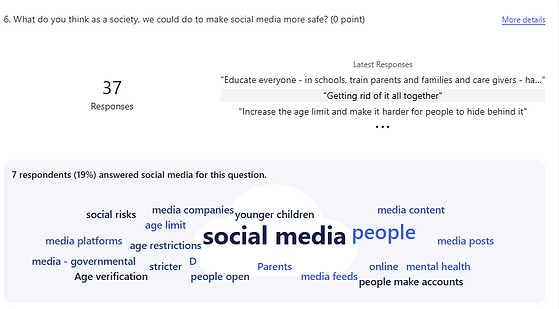
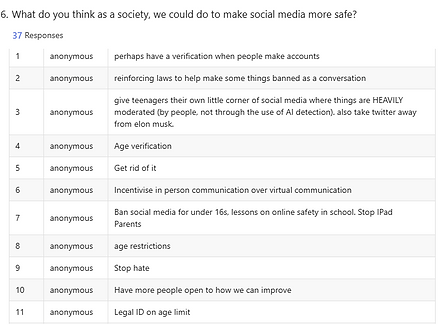
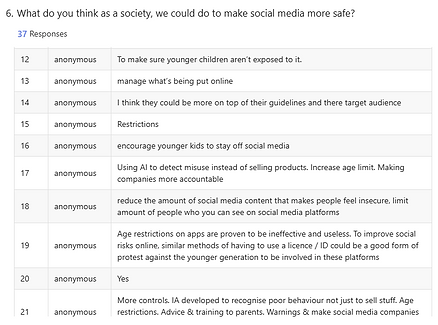
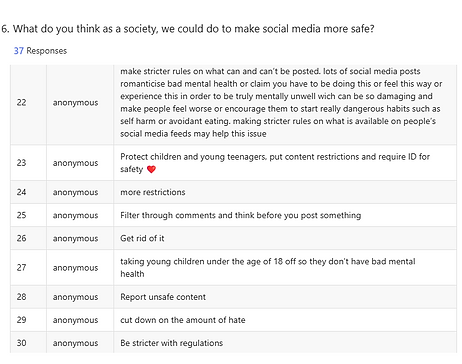
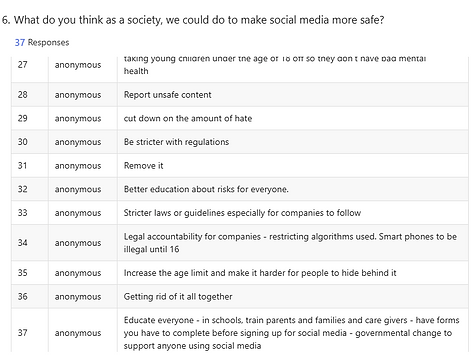
For some reason this one has slightly less than the other ones, but for this question I asked what others opinions on what we can do as a society, to make social media safer? My replies were a mixture of different guidelines that should be added or ideas that others have. The majority talk about certain restrictions, such as safety proportions like verifications, legal ID, getting rid of it completely, and most people spoke about having more restrictions; towards younger kids to keep them safe, to include Ai to detract age, give social media a section for kids, reporting content, make stricter rules on what people can post so they don't influence and harm others. lastly, there were lots of answers suggesting the idea to give schools to educate young kids on harms, don't let under 18s access social media, cut down on hate, make it illegal for under 16s to have phones. All of these answers and more are enhancing the ideas to make social media safer for kids. All these ideas are efficient for my project because if even one of these were done it would improve someone's mental health. A lot of these go over the idea of kids either not having these apps, or speaking on this at school or with parents. I like the ideas of educating but I think the restrictions could also make a huge impact. My audience will watch my podcast looking for answers; so acknowledging everyone else's opinion means I can interpret this into my own work and benefit my audience cause my project will tell kids to stay safe so with this I can further my research and knowledge into other peoples opinion.
Primary research - focus groups
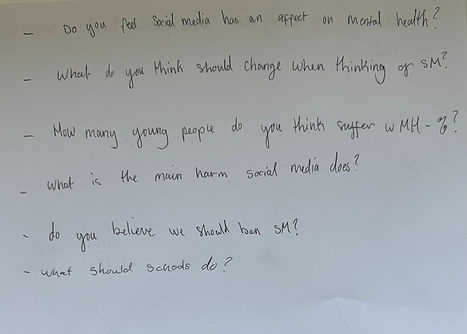_edited.jpg)
I used my survey questions to find questions I want to ask, or further my information on. I had a total of six different questions but I spoke a little throughout the group and asked add on questions. My questions for the focus group included the first question of my survey "do you feel social media has an affect on mental health" the is question is important because I want a bigger conversation on more ideas of further information. The next question I wrote "what do you think should change when thinking of Social media" I asked this because I wanted to find out why my peers felt about social media and the harms. The next question was "how many young people do you think suffer with mental health %" I asked this because I wanted to hear what the would say; I was interested in understanding if they have an answer or not. The next question is "what is the main harm social media has" I asked this because I wanted to know their opinions on what's the worst thing, this way I can realise what harms my targeted audience will feel so I can work on helping that through my podcast. The fifth question is "do you believe we should ban social media" I asked this because in my last project I asked this question and others said no; I thought it would be really helpful to hear more on that for this project. The last question is "What should schools do" I asked this because schools are a massive part of adolescences lives so I wanted to hear from people that aren't in school anymore, what they think schools should do now to help this rising issue from an outside perspective.
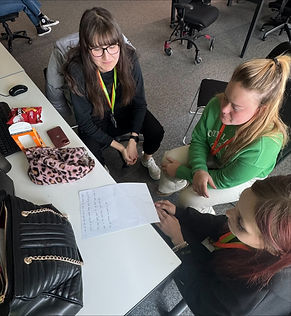
Research
Codes and conventions
Codes and conventions are made from mixture of different elements. For my podcast I will need to use certain types, such as visual elements; like camera angles, location/setting, lighting, framing and how the overall visual looks. Theres also Audio elements like music and sound effects. Both of these are important for my podcast; visual elements in particular is the element I will be paying more attention to, this is because the camera setting for my podcast is highly important because the way my setting and visual appearance of the room looks, the more my audience can connect with what is being said and feel that it’s a safe environment. Audio elements are less important, but I will be using music to open my podcast so its important to think about these codes and conventions. The other types of codes and conventions are Technical elements such as lighting and editing, these are the types of audio elements that I will be focusing on because understanding editing codes and conventions is important when I look at how others have edited their podcasts to get influence from. The last codes and conventions type is written elements, for my podcast I will be focusing on headlines and subtitles, I will be exploring how others use this element and try to reflect it into my work.
Contextual research
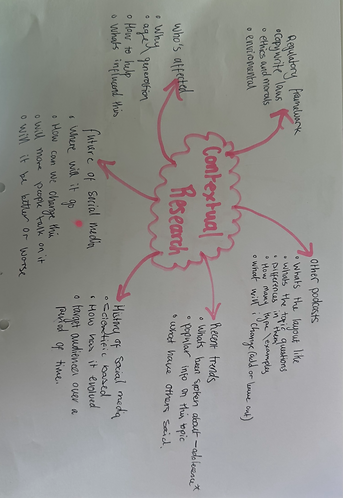
For my contextual research, I plan to focus on other inspirations, and what they did that I would take influence from. This will include other podcasts, resent trends, history of social media, future of social media, who's affected, regulatory framework.
-
For other podcasts, This will be concluded of other podcasts and focusing on what they're layout, so I can get inspiration to see if I would like to do something similar or if I would get a taste of something I definitely don't want in my podcast. what the topic questions include of so for my podcast I will choose a series of questions that cover all the topics that are needed. The differences in podcasts, I will be focused on multiple different podcasts to compare the difference and focus on what I either like or dislike depending on what's being said. This is also helpful to keep in mind because I will be explaining how I got to my production and the links of what I used, when my work gets looked over this will help the viewer get a full understanding of every step to get to where I am now. Another thing to think about when doing podcasts would be the amount of podcast types and examples there are. This would include of how many different types of podcasts there are and what they're used for, for my work I will have to look at the different types of podcasts so that way I can find one that suits my topic best, I will also record this so that the examiners will understand how I chose the idea for the podcast and help understand what I will do or need for my podcast to get the best potential outcome that I can. Lastly, includes of the things I would or wouldn't change which will help my podcast take all the good parts from other podcasts and leave all the bad bits for evaluation and explaining why I didn't chose those parts.
-
The next topic I will be focusing on would be recent trends, When thinking about recent trends we begin to look at what else has happened and what's being spoken about, so for my research I will look at the rising topics and things about social medias harm that others are speaking about when this idea gets brought up. There are lots of documentaries and social media clips online right now, so this is an incredibly suitable time for what I want to project to my audience. This is also helpful because my viewers will get the idea that I have researched up till today's date in order to give a full proof plan of what I want to achieve and produce throughout this project. When I think about the popular information on this topic, I will research into popular incidents that's happened and note down why, who or what is making this popular. This is also helpful for the audience to understand why I chose certain topics to think about. This is beneficial to my podcast as I will get a better idea of what other audiences would know already and like to see/ speak about. I will also be looking at what others have said; this is where I can look at what others have said and interpret if I agree or disagree with the statement. It's also helpful to get ideas from others because it can build your knowledge on the topic and give other ideas and views on something. This is helpful for my podcast because it means i will get a wider description of how other people may also feel about something and not just my own opinion. This will make my audience connect with me more, making them feel more engaged and understand what's going on.
-
Another topic I chose would be on the history of social media, this will help me get a better understanding of the background and where everything started or came from. I will focus on the scientific background because this is where I can research into where it all came from and what actually sparked all the toxicity, my audience will benefit from this because not many people know about the history of social media, and they can get a lot out of it. This piece of research will help me a lot with understanding what's changed and the things that didn't work in the past and made it worse, I will take and reflect from this to create my work of understanding and fixing the old to create a new better. This will make my podcast filled with information on past and present times to get a better understanding on what I need to speak about and the parts I should include so I can create media for my audience to gain knowledge on how social media evolved and why it became harmful. I will also focus on how target audiences have evolved over a period of time, for this I will determine how many people are interested in social media and how that number has risen over the years. I will also look at the ages for this. Because at one point more adults would be looking into social media whereas now it'll be more of the younger generation. This is important as the younger generation are more affected by this and if I can see the change in the audiences, it’ll help my research and help my audiences by getting a clearer view of when everything went downhill with social media but also the age range of when this happened. If I focus on when teenagers started getting more involved in social media, I will be able to talk about why this is bad and why its important that the younger generation need more safety when being on social media. This is helpful to my podcast and project because I want to find out the reasons why social media is as harmful as it is now and when that properly started.
-
Now I will be thinking about the future of social media, for this I will think about where it will go, meaning I will research into what social medias next steps are to make either safer or could potentially make it worse, I will study into the guidelines and see any updates that will be made in the future. This is important as I can tell what social media thinks about these issues and also compare from past to present to future and see if there is any progress with safety and mental health, or if social media wont focus on their harms and improve these apps to make more money rather than safety. My project gains a lot for this because I can connect with my audience to evaluate whats going to be done and what my audience can do in order to prepare for the new media world. I will also look into how we can change this, for example I will take the ideas that social media will take in the future and readapt it to what I would do to make it better or what I would do that's more beneficial for the audiences on social media. This will be helpful to my podcast and project because I can create my own ideas of what I think will be more beneficial to others as well as researching all the guidelines for me to get more knowledge on this situation to create more questions or targets in what I need to achieve because understanding where social medias head is at with these issues are important because if they don’t change some of the rules it will create an unsafe environment for anyone growing up with social medias. Will more people talk about it? This is another one of my subtitles for this as we need to understand how many people are willing to take action to social media in order for it to be a better place. This is helpful for my audiences because if I get an understanding of how many people will or won't bring up these issues, this will be helpful for me to connect with my audience, as a lot of my audience will be open to saying something because social medias harms are affecting them; I also need to understand how many people outside would be able to speak up, or does it not matter enough to talk about. My podcast will focus on making social media safe for everyone and I will need to connect with my audience throughout the video, so understanding that people will or won't talk about it is important for me to get a clear view of if I need to encourage people to also speak up, or if I need to tell my audience to understand why I focus on speaking out and pushing the ones that want too, to do it and help using a platform to do so. The last topic for this would be about understanding if the future will make social media better or worse. For my project this is important because I will focus on making these apps better; but if I look into the future and see what social media are doing then I can interpretate what I need to achieve; whether social media does improve, I will focus on what they're changing and how my audience can adapt to this and help themselves, or if its making it worse, then what will my audience need to do to adapt to this change that could potentially lead them to be worse. If we can catch the idea of it being worse before it happens, we can work around that to learn to keep safe in these upcoming changes.
-
Who's affected? For this I will speak about why these people are affected, their age and generation, how to help and what influences this. I will start off by thinking why this person is affected, so what past issues have brought them to this point, what are their main demographics and psychographics draw them to be affected. This is important to think about because others with similar issues may think the same way which means we can unpick the situation to how or why this is affecting people with similar demographics and psychographics. This means we can focus on overcoming these issues and making them slowly die down. The age and generation are important because unpacking around why there are certain ages being more or less harmed. Age and generation are something that I want to be focusing on as I feel it's the most harmful part of social media, when you have a 13-year-old and a 33-year-old both on social media, the 13-year-old will get influenced more and be more affected. The thing I want to work on throughout this project, is why is that. What is it that's making the younger generation more prone to the harm. Thinking about how to help the audience from this is by studying who's most affected and what other people with those same issues, how they overcame the hate, this is where we slowly unpick out what others have done and sharing that so more people can be open to get that help. This is important for my project as focusing on helping people out of social media is what I want to be able to do, I want to highlight how others overcame issues and with their demographics and psychographics I can build around helping others in the same category. I will also be focusing on what’s influenced this; meaning what are some things that people have done to make themselves more of a target to hate. I can take away things people have done that have caused them to receive harm on social media. This is important so that my audience can understand what a risk in social media is and what you shouldn't do on these apps to help you remain safe. My podcast and project will benefit from this so I can highlight where I discovered the ideas for what is more prone to social media hate and what my audience needs to stay away from doing if they want to remain safe.
-
Regulatory framework includes of copyright laws, which is important because I will need to source everything and make sure my project doesn't cross any guidelines or take information from that could be crossed as copyright because I will get no marks, and my project will seriously be affected. I also need to think about ethics and morals, this is important because I will need to be professional and make sure I keep the right business level of personality throughout the podcast because I can’t be too over the top. And lastly the environmental outcome; for this I can conclude how safe the environment is and if I can talk about a sensitive topic within the place. Overall, I’m still unsure on this topic but I will make sure to keep everything safe and professional. This way my audience will feel comfortable and be able to share their stories in a safe place. I wont make this a section in my research but I will add the link to every source as a form of copyright.
I use this mind map to help me to research into the topics, and also what I need to search and write about for them. I started using this at the beginning of my research but after I kept doing more things I fell into the habit of just knowing what to write. This definitely helped me get started though, because I was horrible at research, which I'm still trying to improve slowly, I can understand what I needed to cover. I used this mind map like a checklist. And made sure I had everything written. Before I submit my work, I will double check I've done everything on the mind map. Overall this has developed my skills of research and gaining easier sense to my audience, because if I understand what I need to talk about; they will understand what I'm saying.
Research - social medias harm on mental health
I started off by research the title "social medias harm on mental health" on google; I found a site that stated psychologists named Amy Orben and Andrew Przybylski, both researched into finding data from three different surveys, about the connection between technology and well-being. they concluded that around 355,000 American teenagers are focusing on questions around depression, suicidal thoughts and self-esteem. I found this site helpful because there was a number on how many young people feel about certain things when it comes to their mental health and social media. As I kept on looking through this page I came across an article with further information for this topic. This site, by the same psychiatrists, discovered that the usage of adolescent on social media has doubled over the past decade.
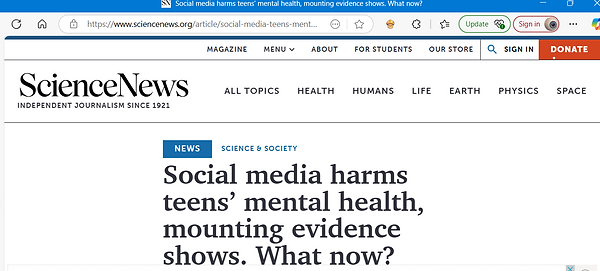
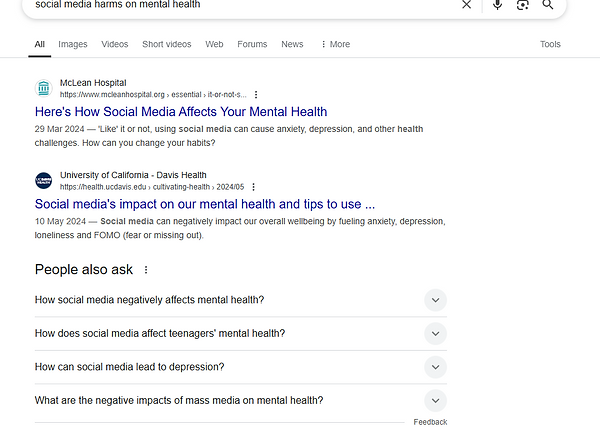
On this site I found a results list for comparing specific results. Here we can clearly see that bullying is so high compared to most other factors.
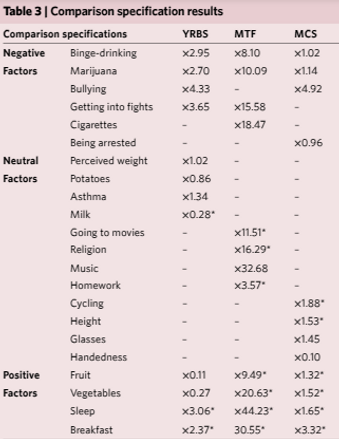
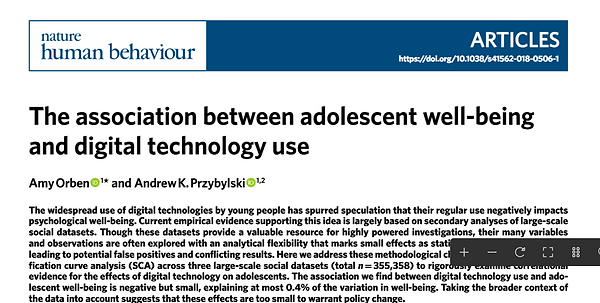
Where did i get this from
who said it
what information does it hold
why is this relevent
what i like
what i disslike
how could i enterpritate this into my own work
I started off looking up the main topic question. "Social media's harms on mental health", by doing this I got a list of links and some other questions that are typed by others. Something that stood out to me was the question "can social media lead to depression". Already we can get that idea that social media must make certain people depressed. One site that caught my eye was called Teens, screens and mental health by the website called: Teens, screens and mental health
in this site they stated some key factors:
-
More than 1 in 10 adolescents (11%) showed signs of problematic social media behaviour, struggling to control their use and experiencing negative consequences. Girls reported higher levels of problematic social media use than boys (13% vs 9%).
-
Over a third (36%) of young people reported constant contact with friends online, with the highest rates among 15-year-old girls (44%).
-
A third (34%) of adolescents played digital games daily, with more than 1 in 5 (22%) playing for at least 4 hours on days when they engage in gaming.
-
12% of adolescents are at risk of problematic gaming, with boys more likely than girls to show signs of problematic gaming (16% vs 7%).
I got these stats off of the website, this states the idea that 11% of adolescents started showing signs of problematic behaviour, by this we can determine that something on social media is altering children's brains to be more prone to fighting, arguing and problematic experiences. To continue this research, I looked up on google "does social media make kids violent. From the Guardian Violence on social media making teenagers afraid to go out, study finds | Social media | The Guardian
it was requested that around 330,000 girls harm themselves, but social media actually making teens harm others? From this website I got to understand that when kids have been exposed to violence of any kind; social media will use that algorithm to produce videos on violence. this means around 760,000 teenagers have said it made them less likely to go out, and other teenagers have acted on these videos they see. This is helpful for my project because I get to understand the issues of kids not only the side of mental health being sad but also the mental health side of anger and disrupt. By looking through this website I understand how teens see these violent videos and how they react with it. This is helpful to my project as I want to be able to understand fully why these kids brains do this and what social media is doing to enhance these issues. I like the range of facts and statistics throughout this website as stats help give a better understanding of what has happened and how many people are effected by this; something I don't like about this website is their shortness of understanding. they have lots of bullet-points type paragraphs but there's not really much description as of why these things are happening. To highlight this into my own work I will use the stats being used to back up my own points because doing this means I can create a better understanding factual argument rather than using my own opinions.
I follow this little plan to make sure I've got all my information formatted correctly.
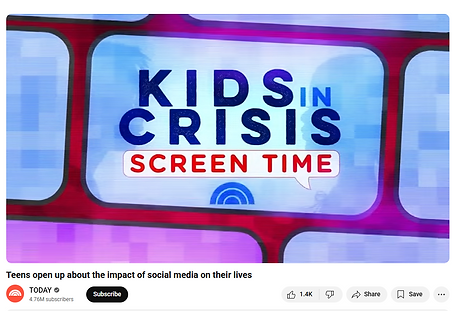
This news show states some facts and an anecdote. It is American will isn't too helpful but the information is still valid and my audience will still learn from this. The first point made is that 95% of teens 13-17 are using social media. because my target audience are based in this age range its reflective towards my project. My audience will understand the importance of understanding how many people are available to these apps. Next a girl shared her story about when she downloaded Instagram, on her 10th birthday party. She stated she got bullied throughout school, she thought that getting social media would stop her bullies and improve her social life. She unfortunately would start looking at models and weight loss programs and posts online; she announced "it went from swapping candy for carrots to how to hide your food and avoiding it completely" she stopped doing this after becoming incredibly ill. the doctors stated if she carried on she would die; her heart, lungs, and other organs are starting to fail. This must be incredibly hard for someone so young, I hope that with my project I can help any kids that feel this way. I hope my audience can reflect on this and understand why restricting yourself is so dangerous. I hope my audience can understand and see that these issues are so horrible and anyone that does suffer knows to contact a help line. Another study that the news article shared was that 46% of teens 13-17 said social media makes them feel worse. My audience will most likely fit into this category, this is also helpful as if we look at both sides to these percentages, we get the idea that 49% of those teens haven't recorded feeling bad. This is a very close percentage; a lot of teens are in dial about their phones and will never admit to that therefore its tricky to get a estimate on who's actually affected.
_edited.jpg)
My mind map of notes from the news article. I didn't focus on production skills here as this research is to do with the information, not how its laid out. I focused on valid information that helps reflect on my work and project. I also made sure to work out the percentages, which you can see on the piece of paper.
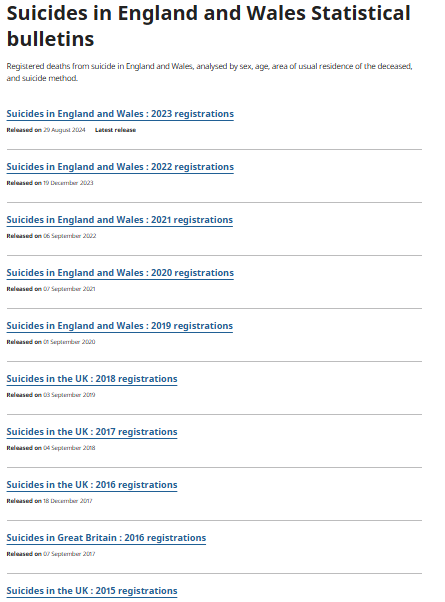
Here is where I found the information to suicide rates that I will be mentioning in my Podcast. My audience can gain a lot from this because it highlights how big of an issue it is.
Jonathan Haidt speaks about a massive suicide increase after social media came around 2012-2015. So I looked at the office national statistics. The first thing I did was go onto 2013 to look at the rates as that's a year after social media. I found that in 2013 there were 6,233 suicide's ages 15+. Men and women: statistics | Mental Health Foundation also stated that men's suicide was three times higher than women, with 2013 being the highest suicide rate since 2001.
I then looked at 2014 which was 6,122 suicide deaths for ages 10+, already we can see a increase suicide as a whole, and an increase in adolescence suicide.
I found on 2023 ratings; this graph. This graph shows in 2012, between 15-19 year olds, that there were 3.6 out of 100,000 people died from suicide.
In 2014, between 15-19, there were 4.6 out of 100,000 people died by suicide.
And in 2015 between ages 15-19, there were 5.5 out of every 100,000 people died by suicide.
Why is this important?
This is important to my podcast because I wanted to check Jonathan Haidt's facts and look at the ratings myself; I figured out he is correct where he's going but its not as massive as he said. Although these are British ratings and he is American. My audience will benefit from this research because I'm giving them the facts and sharing every view on this I know, that way they can be as knowledge as I am on this topic. The more knowledge they have, the more they will understand to keep away from the harms.
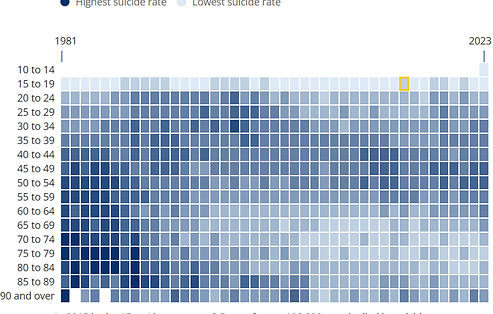
Mental Health FOMO
The Social Media and Mental Health Connection
This website states the idea of social media causing FOMO (fear of missing out,) they speak out Instagram and Facebook being the main two, because you're always looking at what other people have, either missing out on the latest trends or gossip, or missing out on valuable products because you cant afford them. This website states the symptoms caused by this to be tethered to your phone and you are constantly checking for updates or responding to every single alert. Personally I think it's much more than this.. I looked more into this to find a different reasoning. The website FOMO: Causes and Solutions | Psych Central stated that there are physical health issues that come with this, that being fatigue, headaches, lack of motivation, performance issues at work or school and burnout. But it was also mentioned that there are mental side effects, including, anxiety, depression and fears of loneliness. Overall I couldn't see anyhting to do with how to know you have it-like symptoms. This is beneficial to my project and audience because this will back up my point that there are some mental health issues that are somewhat caused by social media. In every website I looked at for information on this; they all mentions the link with social media:
The Social Media and Mental Health Connection
FOMO: Causes and Solutions | Psych Central
Fear of Missing Out (FOMO): 13 Mental Health Effects
The Psychology Behind FOMO (Fear of Missing Out)
This is highlighting my point on why teens
shouldn't be on social media. Developing these
symptoms at a young age is highly damaging.
My audience will look at this and hopefully
realise how harmful these apps can be. I'm
also hoping parents will acknowledge this and
regulate their child's phone or set boundaries.
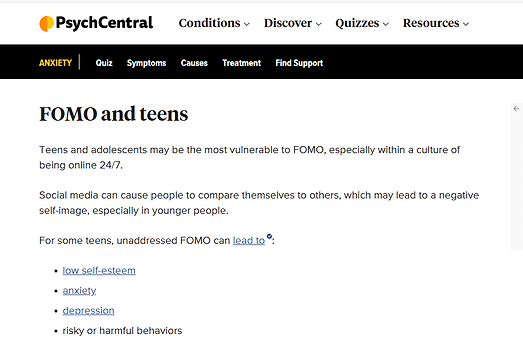
Guidelines
Here I will focus on the Guidelines of these social medias: TikTok, Instagram, Snapchat, Twitter and Facebook. These guidelines will help me understand how these apps are dealing with kids and how these apps deal with harm.
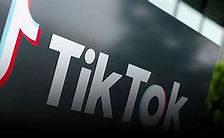.jpeg)
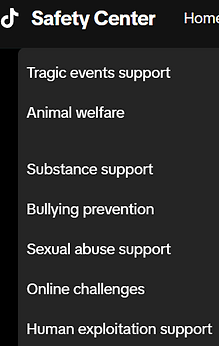

TikTok
The first Guideline I will be researching on is TikTok. For the TikTok guidelines I used TikTok's official guidelines website: Community Guidelines | TikTok. This website went through the guidelines. The website: TikTok: What It Is, How It Works, and Why It's Popular. Explains a bit about TikTok's upbringings. TikTok is an app that allows people to make content and share entertainment all over the world; these short videos from 15 seconds to 1 minuet long, wit a range of trends, challenges and even a place to find cheap items. TikTok is the main source of entertainment for this generation, but with good comes bad.
The first guideline represents Keeping their platform safe, trustworthy, they acknowledge creative expression and hope this will be preventing harm. they have a combination of safety approaches to strike the right balance. This is called Content Moderation.
The second guideline is about Removing the content that they do not allow. For instance; violent and graphic content, nudity and sexual activity, misinformation and fraud, and lastly drugs and controlled substances. For this guideline I had some help with researching from: What kind of content does TikTok censor? - Master Metrics. Which showed me the types of content TikTok doesn't allow. So far these guidelines are beneficial to my project because understanding what they don't allow helps me indicate what could be harmful to others. I am researching into guidelines because I want to try understand if these apps are trying to help with kids safety, or if these apps don't care. So far TikTok's guidelines seem suitable and what would be known as "norm", my audience can benefit from this because I can share information on what these apps are doing and what they could do in future to keep their audience safe online.
The third guideline is Restrict content that is not suitable for youth. This is an important guideline when I think of my audience; this is a mode on TikTok that can be turned on and off where TikTok limits exposure to certain content that may not be suitable for everyone, some features of this mode stops you from gaining access to the Following feed, going LIVE, and gifting on LIVE. There are different types of content they don't allow, such as content that contains mature or complex themes, Profanity, Sexually suggestive content, Violent or other threatening imagery, Firearms or weapons used/featured within an inappropriate context (prank and stunts with warning is okay), Illegal or controlled substances/drugs in any context, Explicit references to mature or complex themes that are only suitable for older audiences. Website helped me understand this guideline, and how to change this setting to on or off: How To Turn Off Restricted Mode on TikTok | High Social.
The forth guideline, Make ineligible for the FYF content that does not meet our recommendation standards, this guideline is speaking about the FYF (for you feed) which is also known as the FYP, this guideline pays attention to what's being published on the FYP (this is where TikTok generates content that other people have made that the app, based on hashtags, you would you like) these issues are based by any video indicating dieting, (videos promoting weight or body in a harmful extent to others), extreme fitness, (promoting activity that is likely to lead to moderate physical harm), sexual suggestiveness, sadness-- TikTok stated that some frequent videos overgeneralized mental health information for example there are types of quizzes that claims to diagnose someone. My audience and I both know this is wrong because TikTok are influencing these kids into assuming their depressed which could alter their brains into developing issues like this in the future. TikTok have enabled a safeguarding filter to make less of these videos appear, This is extremely good and helpful to people struggling with mental health. This also shines a reflection on how far fetch mental health is going in the social media world. My audience will gain information and knowledge of how bad TikTok can be when the wrong influence is showing. I found the safeguarding info on the website: An update on our work to safeguard and diversify recommendations - Newsroom | TikTok.
The final guideline is to Empower our community with information, tools, and resources, this includes a safety toolkit (the first safety tool is the feature where You can choose who can view your video like friends, followers or private. Another feature is you can control anyone who DM's you, TikTok have also made it so Direct Messages are only available to registered accounts who are 16 and older, also parents or caregivers can change this by restriction or turn off through family paring, you can also decide who can see your comments and who can comment on your videos, comments for people under 16 are set to ‘Friends’ by TikTok which is an important feature to kids as it reduces the risk of harm, my audience would agree and find this interesting, this could also make my audience feel safer on this app, you can block and restrict people, give or take away access to people you don't want duetting, downloading, like and stich your videos.(website of information: Community controls)),Account controls (this is where you can chose language preferences, screen time, religion, private or public account-- accounts for people under 16 are set to private at the start, this is also great for my audience as it will remind them of the danger possibilities and help them remain safer, (website: Account and privacy settings | TikTok Help Center.) and in-app features with safety resources. (TikTok has designed a feature where you can actually get help for certain issues, here is all the information topics they include. This is great for my audience as they can be aware on being able to get help if they need to.)
Overall I think TikTok have thought about the issues going on and are trying to repair them which is great because my audience will learn how to be safe and with guidelines there to protect kids makes the app feel safer as a whole. One thing I would change or add would be the age to download the app which is 12+, this is crazy to me and I think this should be changed. Another thing I would change would be the way even though these apps have a feature where under 16s start off with a private account, I think it should be a consistent thing to remain private UNLESS their parents sign a contract with TikTok to make public content. I believe by doing this it will keep celebrities going with their jobs and keep adolescence's away from creeps and the public eye. These kids can post with their friends but not for the world. No one will be begging to watch minors tiktoks and the minors that want to post can gain a following with their close friends to see. Personally I think this will benifit the app users and my audience because it's protecting them from serious harm.

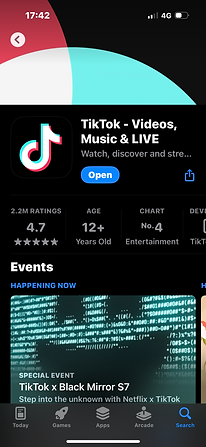
.jpeg)

Instagram
Instagram is an American photo and short-form video known as reels, social networking which like Facebook is owned by Meta Platforms. It allows users to post media that can be edited with filters, be organized by hashtags, and be associated with a location via geographical tagging. Posts can be shared publicly or with preapproved followers. They have a messages page, reels and search. Meta has also published an app called threads, which is linked through your Instagram account. Instagram's guidelines insist of (website used for information: Instagram Community Guidelines FAQs) Intellectual Property which is the first guideline that makes sure you have the right to post the content you share. On the reports you can manage copyright, trademark and counterfeits. (Intellectual Property Reporting Center) . The second guideline is Appropriate Imagery, this includes things like nudity, but paintings, scarring or women breastfeeding are usually okay. I personally think that this is very considerate to mothers with what they can post as it symbolises that mothers feeding their babies, isn't the same "nudity" found on an exploitation page; if it were this could cause mothers and my audience to feel ashamed of their body and feel the need to not post their type of content.
The next guideline is the use of spam, this includes things like making and sending unwanted DM's, comments, likes, and other forms that would be classed as harassment. The forth guideline is about Illegal content. These include supporting, praising or creating organised crime/ hate groups that advocate terrorism, offering sexual services, selling firearms and drugs. This is good for anyone under 16 who may experience chainmail, this is common and can be very scary for someone young. Getting spammed makes you feel like someone's always watching your every move so for spamming to be removed it takes away that feeling of being watched- this will help out my audience a lot to be safer and feel better on the apps.
The forth guideline is about Hate Speech, Bullying and Abuse. The hate speeches targeting of private individuals, Instagram also doesn't allow attacks or arm towards groups of race, ethnicity, national origin, sex, gender, gender identity, sexual orientation, religion, disability or disease. This can make people in these groups feel ashamed of themselves or cause their mental health to colapse. My audience can learn by this from the idea that these things are wrong; by understanding that these are wrong there will be less hate and the less hate around Instagram means my audience will feel at a safer place.
The fifth guideline is about self injury this includes self-harm, purposely injuring yourself in stunt matter, and eating disorders. Although, Instagram mentioned how if a post references self-injury and or eating disorders for the purpose of creating awareness or signposting support then the post isn't violating the guideline. I think this is appropriate because it can reduce the harmful content that could trigger someone; but also because they will allow it if its spreading awareness then people have a chance to learn from it, my audience will benefit from this because anyone that suffers from mental illness will now know that they are less likely going to be 'triggered'.
The final guideline is Graphic Violence In instagram the types of graphic violence are fighting, blood, death, pornogrophy, and other acts of harmful violence. Instagram went through a phase that lasted around 2 days, where most people got flooded with harmful videos... Here's what Meta admits Instagram error flooded Reels with violent and pornographic content | TechSpot said about it, they stated: "Instagram users to see a slew of violent and pornographic content on their personal Reels page. The company has apologized for the mistake, which resulted in video clips filled with everything from school shootings and murders to rape being shown" This could seriously effect the young generation that's on this app. Instagram has made their app 12+ and to have a default like this could seriously affect a kids innocence. Thankfully now Instagram has sorted it out and has updated their guidelines. Meta apologizes for error that exposed some Instagram users to violent content - CBS News. Stated that Meta apologised for this behaviour, and it was stated that Meta changed their policy in January to end its third-party fact-checking program and replaced it with a community-driven system used by Elon Musk's X social media platform where volent content is always showing. A coincidence? My audience will understand these guidelines and take Instagram with more caution, unlike TikTok, Instagram has slightly less guidelines with not many safety security for the younger kids. Instagram labels their app 12+ but doesn't do much for the safety of them. TikTok did far more for the younger generation and I think my audience would agree to keep Instagram at a safer distance if you're younger.
If I was Meta, I would up-grade Instagram's guidelines to benefit adolescence more. For example, like TikTok, I would make all Instagram accounts private under 16 unless parent contracts are signed. And I would make it a feature that no one over 18 can message under 16 year-olds unless the child's parent signs and says they give access, this way podophiles and groomers cant send underage kids messages.
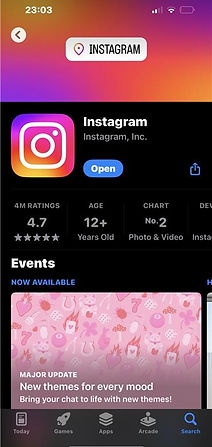.jpeg)
Snapchat
Snapchat is a social media app used to take photos, call, message or view stories of your friends and others all over the app. Found these on the website Community Guidelines.
Sexual Content is the first guideline and website I used to research into the guidelines. Sexual content is a massive issue among snapchat and I discovered that 6% of teenagers (ages 13-17) reported sending explicit content on Snapchat, this was linked to the website Was Snapchat originally made for sexting? - California Learning Resource Network. Snapchat's sexual exploitation mostly aims towards kids; which is good for that younger generation and keeping them safe but why does the whole app focus on the children when they should be seeing the signs to keep kids away and stop adults from failing into the unsafety, another type of sexual content snapchat don't approve of is abuse of a minor, sharing child sexual exploitation or abuse imagery, grooming for sexual purposes, sexual extortion (sextortion) or the sexualisation of children. Never post, save, send, forward, distribute or ask for nude or sexually explicit content involving anyone under the age of 18 includes sending or saving images of yourself. All these guidelines seem to be good and will help resolve the issues snapchat face; but snapchat is too focused on protecting kids that they haven't thought about the adults who groom the kids or the adults that harm each other. Overall this was helpful to my project because I want to learn about what snapchat have done and what I believe they should do. My younger audience will be pleased about this because they can feel more safe and understand these regulation's; for my older audience they might feel overwhelmed and wont like this idea that only kids get these safety regulations. Furthermore I think they should upgrade the policy to be available for everyone. Harm is harm no matter the age.
The next guideline snapchat has included is the threats, violence and harm, the type of harm this app would consider offensive is intimating or threating a person or a group, snaps of graphic violence, animal abuse and glorification of self-harm/ injury and eating disorders. This is helpful to my project because I study into mental health, and understanding parts of harm that surrounds mental health is good for my audience to realise what they should stay away from doing, and getting triggered or influenced into doing the same.
The next guideline snapchat follows is about hateful content, terrorism and violent extremism which means any discrimination and or violence on the act of racism, caste, ethnicity, national origin, religion, sexual orientation, gender/ gender identity, disability or veteran status, immigration status, socio-economic status, age, weight or pregnancy status. These different hate violations are extremely harmful and effective towards the audience. Snapchat can become very harmful so to make sure no one is receiving hate is important; this is because the hate or words someone speaks about can sometimes reflect on that person to do the same as if was "funny" or "normal", this is why we need to create a barrier where kids aren't getting influenced to grow up doing the same; the other path this could take is in the direction of bullying and harassment which can cause someone's mental health to decrease rapidly, making that person extremely ill. A lot of my audience will struggle with mental health issues so it's important they understand these guidelines and know to report anyone giving them violent extremism, this will benefit my project because I want my audience to feel safe and secure on these apps, so understanding the guidelines snapchat have are important.
The next guideline is Harassment and Bullying; these are including sexual harassment, sharing others personal information and or space, and reporting someone else repetitively for no reason. These are important for my project because I want my audience to know and understand what is classed as harassment and bullying; because they should feel safe and know what to do when someone is being harmful. A lot of snapchat guidelines, will only be used if someone else reports you; therefore this puts people off because they aren't sure if it's valid or not. Personally, to solve this issue, I would send a warning to both people explaining that the 'bully is harassing you, report here' button and for the bully I would suggest, 'you're disobeying the guidelines', this way the audience will understand what is harmful and what isn't, it also gives a fair advantage into making the app safer. I think my audience will benefit from this guideline and the improved guideline that I thought about.
The next guideline speaks about illegal or regulated activity, this includes things like human trafficking, buying or selling drugs, alcohol, vapes, tobacco and other forms of weapon's and trafficking types. This one needs more looking into, because the amount of drug dealers that use snapchat as their main source is crazy. If snapchat improves the drug issues then the app could be a lot closer to become safe for the audience, understanding this in my project is important because a lot of podcasters speak about social media being intwined with drugs.
The last guideline snapchat has is about Harmful False or Deceptive Practices. At first I was confused about this so I read more on their website Harmful False or Deceptive Practices. This told me that any false information like denying the existence of tragic events, hiding or lying on behalf of the medical fields (they spoke about COVID19), the second thing they mention is about fraud which includes anything that is causing someone financial harm. The last topic to mention is Spams, anything that harms someone by repetitive, or frequent posting/ sharing is pronounced as spamming. Overall this is helpful to my project and audience because understanding that someone's actions are wrong and harmful are important to keeping people safe and away from bullying. This will overtime make snapchat a safer app for everyone.
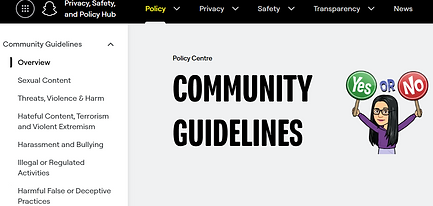

.jpeg)

Twitter / X
X formally known as Twitter is probably the most harmful platform out there. I found my information on their website: Rules and policies. Twitter has barely any guidelines with no information on them, which is expected, these all include of: Platform integrity and authenticity, this includes things like spamming, platform manipulation, API abuse, and information operations. This is helpful to twitter because constant spamming of harm because a lot of things on twitter are constant spam of bots, understanding this will help my audience recognise what's harmful to others and help remain safer and cautious. The second guideline is about Safety and cyberbullying. This include of abuse of all kind, harassment, and criminal actions. Twitter doesn't give much background on what they don't allow under these conditions. That's why my audience will note that a lot of issues other apps cover, this app leaves out. My audience will benefit from this because I will highlight that important factor that Twitter isn't as protected as the others. The next guideline includes Intellectual-properties, this means anything invading someone's rights of properties and organisations. My audience will understand that this doesn't really apply to them as a lot of my audience is the younger generations. Therefore my project is proving the idea that twitter need to cahnge violeations of someine under 18 shouldnt be using the apps. Twitter Age Limit: Minimum Age to Use the App | TweetEraser explained that twitter is 13+, the others are 12, so slightly better. And they also mentioned that any under 18, can't create adds or promote tweets. My audience will learn from this as a lot of them will be under 18, the audience over 18 can help remain these safety issues by helping the guidelines do more for the younger generation. The last guideline is about creating multiple accounts. Spamming accounts can make you seem like a bot or get out of the guidelines, therefore this is good for my audience because it reduces the risk of bullying. When you block an account it'll be harder for the bully to make a new account and add you back. Overall there wasn't much information and I think twitter needs to do so much more in order for this app to be safe among the younger generation, and anyone with bad mental health. My audience will only gain the knowledge to keep safe and be careful what you look at on twitter because these guidelines don't help anyone's safety.
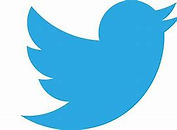.jpeg)

Facebook is a social media app that's been around since 2004, being the oldest platform I've researched on. With Facebook you can do all types of things like, post comments, share photos and post links to content on the web, chat live, and watch short-form videos. You can even order items, clothes and food. This information I got was from: Facebook Explained: Origins, Why People Like It, and Key Features.
The first guideline Facebook includes of is to only share photos and videos that you've taken, or have the right to share, this guideline indicates the idea of copyright, my audience can gain a lot from this because they can post their photos without thinking it'll get re-posted by someone else. This is also helpful for a lot of brands that crate an idea photo/video and risks someone else stealing it and classifying it as their own.
The next guideline includes the idea that every post has to be appropriate for a diverse audience; this means nudity, partially nude children, but they stated that sculptures/ paintings of nude are okay and anything supporting or spreading awareness on breast cancer and breast feeding are also okay. This is good for my project because my audience can learn about the dangers of certain posts but also be happy that they can share support without the need of being triggered or upset with the outcome.
The next guidelines are about foster meaningful and genuine interactions; this includes making the app become spam free, stopping giveaways that are in exchanged for likes, comments and etc, fake reviews and ratings and self misleading info. This is helpful to my audience because they can understand if someone is being honest or lying; lying on social media is a big problems, so by understanding this means my audience will be safer when talking and exchanging things with strangers, my project will gain lots of information and understand what they're doing that's helpful and what they could change; Facebook is age 13+ so they could add more guidelines for the younger audience.
The next guideline is about following the laws; this is activity like hate crimes, terrorism, selling illegal products or sex services, and any form of sexual violence/ discrimination. This will help my audience understand that they wont be receiving any forms of illegal activity on Facebook and this will help my audience understand that they can be semi-safe when being on the app.
The next guideline is about no glorified self injury; this includes things like promoting eating disorders and self harm. This is good for my project because a lot of my audience will struggle with self-harm and by understanding that these aren't allowed my audience will notice they wont or shouldn't be triggered by unexpected photos of self-harm or eating disorders; as this can be really harmful and triggering to my audience.
The last guideline is about Graphic images, such as graphic violence, blood, gore and anything unsettling. This is helpful for my audience as they can expect to not see anything harmful meaning this will protect a lot of younger kids on the app. Overall Facebook have guidelines that are appropriate for kids and by doing that makes the app safer for everyone, This helps my project because it helps my audience understand what the safety procurations are.
.jpeg)
Podcasts
For Podcasts I will be focusing on the subject matter of what they're talking about, the way the video is laid out, what their setting looks like, if they include music and the techniques side of things like camera angles, amount of cameras and mics.
I searched on YouTube "Podcasts on social medias harm" these are the podcasts I chose to do to help my project and my podcast.
Heartbreak, Fear, And Becoming Unstoppable - Andrew Huberman
- The Ugly Truth About Social Media (youtube-link-click-here)
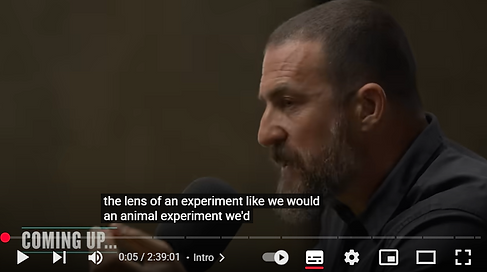
The ugly truth about social media was the heading that appeared when I searched for podcasts, although this was a 2 minuet video. In the caption the host of the podcast posted the link to the podcast Heartbreak, Fear, And Becoming Unstoppable, this was the bigger podcast that stated the social media issue in a part.
To start off, I watched the podcast and made notes. I used 3 different colours for: Technical, podcast (info) and visual.
74K likes and 1,469 comments.

To start off, the podcast opened on a minuet long clip of what to expect and what's coming up. There wasn't any music though. For my podcast I also want to do a minuet clip of what's coming up but I want my podcast to include some kind of music. Another thing I don't like is the darkness of the setting. Rich Roll's podcast also did this and it makes the podcast really dark and gloomy, therefore I want my podcast to be light and colourful. They use a table with two chairs and two mics, the host has a laptop in front of him that has information on either the subject matter, a script or questions. As the host asks a lot of questions, my take on this would be a series of questions the host wants to ask. I also will be doing this for my podcast so I can have everything in front of me. The podcast is made up of a series of different sections; they are split up by the hosts topic questions. The host speaks around 10% of the time with the guest 90%. For my podcast I would prefer to do 30% host and 70% guest.
Now going into the information that's being said, the guest Andrew, spoke about the connection between social media/ cell phones and dopamine. The first point he makes is this idea that when you're scrolling on your phone, on social media, you're no longer getting a novelty, this means that when someone spends all day watching videos it becomes more of a movement because its constant, rather than actually enjoying it. Another idea of this is the dopamine that social media gives to you with no effort. Humans work to get dopamine, you work for a reward, so when a person is getting fed dopamine from social media or drugs then it gets less effective because why work for that reward when it gets handed to you. This will help my audience get a sense of idea of how harmful social media is because Andrew related it to drugs. I will use this idea of using human energy boosts to explore into harmful substances. I feel as though my audience can reflect on this and create a better idea of its harm. The next information Andrew spoke to us about was the algorithms for social media, and how they are very clever, the algorithms that have been incorporated function on the most powerful way to keep people doing a behaviour. When you get an intimate reward for doing something your brain iniciates to do it again. Andrew then speaks about how he relates it to gambaling, this can make my audience more aware on the dangers and slowly start to unpick how social media is a bad addiction. Andrew states that becuase when you scroll on social media and come across a video that excites you your dompamine levels rise, when they go back down after the video your brain still wants more of that 'hit' so you carry on scrolling waiting for that boost of one minuet dopmamine. I will definateltly be incorpiating the idea of drugs and gambling being in the same addicted mind as social media. My audience will find this inforamtion and be more warey of how to approach social media and with this I can help my younger audience iniciate screen times and let them grow to understand to stay away from constant social media use. Andrew states we have to self regualte ourselfs the amount of time this happens, but for the younger generation thats sightly harder therefore in my podcast I will try to help others by stepping over this and create a plan so they can stay away and also learn how to in future. The next point that caught my eye in this podcast is when Andrew speaks of the dompamine of social media and the mental illness OCD; he states that social media looks as initaly very dompaniergeric driving reward suprise and excitment but very quickly transformed into something more like OCD. He states that its the kind of behaviours that if we saw ourselves through a lens, with phones as the expiriment of dogs keep looking and digging for a bone, its sad to watch, thats us we are sad to watch attaching to phones. Thats why we have to slef regualte the amount of time we spend on these apps. I wouldnt put this the same as Andrew but I can understand where hes coming from. Personally I wouldnt label it as OCD because people suffer with this disorder and isnt something used to descirbe a topic. I do like the idea of looking at ourselves like an animal experiment and I might try to encounter that into my podcast because I think my audience can real get a feel of what it would be like when looking at ourselves on social media through a lens. I also hope my audience will understand this and agree. The final thing that can be spoken about is the idea that you can only create a positive anticipations so many times and then create a let down, before completion that's delivery of the promise has very little impact. Like giving your child ice-cream every time the pass a test, that dopamine of ice-cream will slowly feel less and less like a reward and just a common boundary. Andrew used the scenario of drugs and correlated them together by stating that dopamine that arrives with zero effort, destroys people- like drugs, cocaine or methamphetamine, give off high levels of dopamine with no effort, the only struggle is by getting the drugs, which for most drug users, isn't a hard thing to do. Overall I got a lot of information on dopamine and how social medias addiction can tie into harmful addictions. I will be sharing this with my audience as I think it's important to make those kid of corrolations and for my audience to be more safe, they have to learn the harms. I think for my younger audience this is a much better way of putting it as they will have this dark horrible education on drugs and therefore to compare the two together; they will feel more put off by social media making them more warey when using the apps.
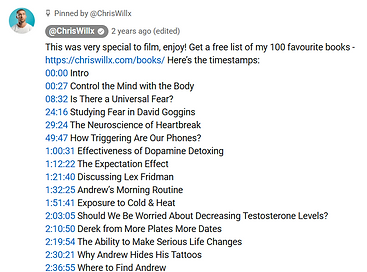
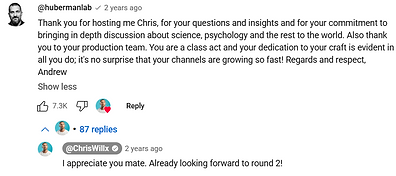
This is Andrews and Chris's comments on the video. Andrew is thanking Chris and his production crew for everything.
Dr. Jonathan Haidt: How Smartphones & Social Media Impact Mental Health & the Realistic Solutions (link here - YouTube)
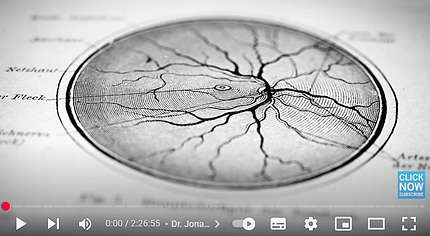
This podcast's host is Andrew- from previous podcast and he's joined to with Jonathan Haidt who I've taken lots of my information and influence from. I think this podcast was fit for the second as we can get an insight to what Andrew is like as a host. This podcast is 2hours and 27 minuet's long, I listened to this podcast on 2x speed to get the information in quicker. Again I will be using a mind map and describing what's being said, the technical side and the visual. 15K likes and 1,140 comments.
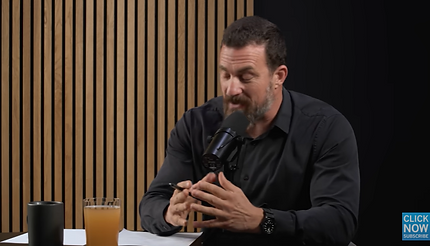
A point I want to make before I start is that Andrew states that social media isn't an addiction or habit, its an OCD, obsessive compulsive loop. Which like I mentioned previously I hate how Andrew associates social media to a mental illness but he made a valid point that it is exactly that. Jonathan then comes back and states that he disagrees because its not like watch your phone or something bad will happen (that's what OCD does) but instead he mentions this idea that if a child was in class with a PlayStation, Xbox, tablet, colourings then would they listen to the teachers boring lesson, or would they play. The podcast is filmed in a dark room with a table for both people to sit at, behind them in this dark room, there was a brown wooden board reaching across them, I have this same wall in the back of where ill be filming my podcast. To start off the whole podcast is in mid close up shot, with two cameras. When the podcast first starts there's an introduction of a couple photos with Andrew stating how they speak about all things science, which is good because I want my project to be based of scientific detail, then Andrew is in a dark room all to himself giving an introduction to Jonathan Haidt and his book, what he does and who he is. Andrew starts off the podcast by asking Jonathan when did the exact date, year, month where everything changed, "was it when everyone had a smart-phone?" (2010-2012), Jonathan states that when the internet came out everything was good, you didn't have to go to the library to find something out, and when you had a flip-phone it was free to call so that was amazing; this is where Jonathan explains that this is why its mostly social media rather than the phones, now you can spend all day on your phone compared to before when you would use the flip-phone for a matter of minuets before it gets boring. Jonathan then generalises the idea the flip-phone was a tool- you use it- you put it away, but the smart phone you can scroll for hours as it has everything you could need. So far Jonathan has taught us the idea that its not about the phones but about the apps and that idea of the the world being changed is scary. My audience will learn about the difference in times between the flip-phone and the smart phone, I will gain this knowledge through Jonathan's understanding of what's happening this is because I want my audience to understand what its like in these different generations. I also want my audience to validate the idea of going outside and playing is far better than staying watching a screen all day. The majority of the world states how GenZ are speaking up on mental health, but this is because in 2012 the world changed, men were becoming slowly depressed and women were putting themselves into psychiatric wards and hospitals for self harm and other behaviours. Jonathan Haidt explains that if you want to find out why depression rates for females have grown faster than males all over the world, its because, unless someone can find some hormone disrupting chemical around 2012 there is no altered explanation as to why social media isn't the only explanation as to why this is the case. My audience can view this and believe social media is the cause or they may believe in their own opinions but personally I will be reflecting this onto my audience so that they can understand better where mental health started its roots and how social media came around. From this I can understand the message Jonathan is portraying and the way he's expressing it is through opening our eyes up to the other issues that happened in that moment that's when social media really impacted on our lives, another valid explanation to give to my audience that there is a need for play over phones, this leads onto my next point that Jonathan made. This is the idea that kids spend five or more hours on social media at least three hours on their phones away from social media three hours on video games six hours at school and buy 2010 every child went from having a play based childhood to a phone based childhood. This is scary because it highlights the idea that children care more about their phones rather than experiencing the outside world and this also indicates that parents don’t see the bigger issue and will give their child a phone so they fit into society rather than helping them explore and learn outside like most mammals. Overall this podcast is very helpful to my audience as they can get insights to what life was like when the flip phone was around and what life was like after the smartphone. We can also indicate this idea that social media was a main cause of mental health and depression. Jonathan gives us ideas as to when in 2012 is when the world changed; we can indicate this is the time that social media and mental health came around. My audience can learn a lot from this and even with their own opinions they can also share and understand that this case may be a possibility this will lead them do you want to stay off their phones less, and will take more caution on social media.
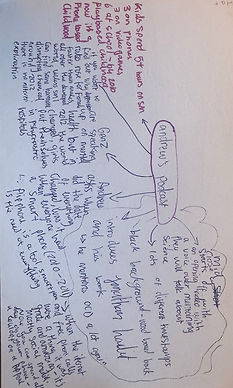.jpeg)
My mind map of what I was going to speak about.
Is Social Media Ruining Your Mental Health? | Dr K Healthy Gamer
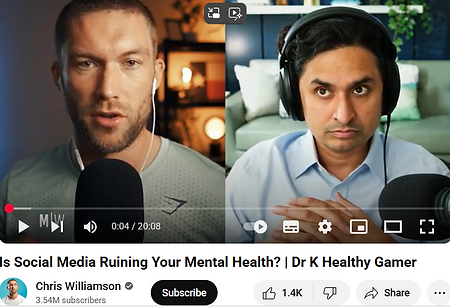
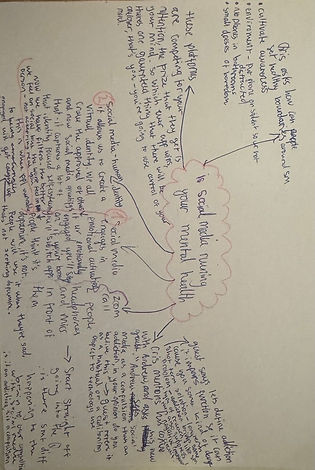
Before I start I want to mention how this is the same host as the first Podcast, and mentions Andrew his guest. The link to this YouTube video is Is Social Media Ruining Your Mental Health? | Dr K Healthy Gamer - YouTube
this video is 20 minuets long which is shorter than my usual ones. This podcast also is on zoom so I wont be talking much on the cameras. As for the setting there isn't much to talk about so I will mostly be talking about the information, I wrote down my notes along the way which help me organise myself. Even though it does take longer it's more beneficial for my work and I achieve the best results. 1.4K and 89 comments.
This podcast is set on a Zoom call with two people, the background for the host Chris is quite dark like this podcasts but the yellow light brings out the idea of warmth and comfort which makes the audience feel at home and move involved in what's being said. The guest's side is very bright office-like, this can bring more idea to the audience to acknowledge that he's a doctor; this can make the audience believe what he's saying as there's a higher level of respect to doctors and their work. They both use headphones and have a microphone in front of them. The podcast starts off straight away with the opening question by Chris "is there something different happening to the brain, to our compulsion with social media, is it an addiction, or is it a compulsion" this starter question can be confusing to certain people and what this means is does social media make you act in a certain way which is something my audience may be looking for. The guest then speaks about his idea of there being two different points to this, the first point is the idea that social media engages in emotional activation. This means if you're emotionally engaging you'll stay on scrolling through these apps, if you're bored then you'll switch or move to a different source of entertainment (another app or game). People would usually associate this with dopamine, Dr K says its not because when you use social media you can be sad, a lot of people with be upset and go to social media forcing themselves to feel worse. That's not seeking dopamine. This is when people who are vulnerable to being emotionally engaged will get caught up in social media. This point I think something a lot of my audience will understand, this being the idea of going on social media to feel worse. So already my audience can gain a lot from this as they can relate heavily to this idea, which then will keep them entertained and keep watching. The second point, is about social medias 'human identity' because social media now allows us to create this online persona, creating a virtual identity. We all crave the approval of others and Dr K mentions how social media captures that thought and quantifies it. This also captures self-esteem issues because now we have filters, filters make you feel more approved by social media and makes your virtual identity look to your best; whereas we will feel worse about our real selves and this will lead to not accepting yourself. I think my audience will benefit from this because lots of my audience will struggle with their mental health and because of this they can understand how bad filters can make you feel. My audience will capture how real this all makes sense and will gain a lot out of this because they want to understand about these issues.
The next point I want to talk about among the podcast is when Chris mentioned the first podcast I wrote about when Andrew and him spoke about OCD, Chris asks Dr K "Andrew sees social media as a compulsion (OCD) than an addiction, do you believe there is a difference between them or what's your opinion" Dr K then asks to define addiction in this sense as it impairs functions so it can cause you some kind of dopamine. A short term solution and a long term problem, addiction brings some kind of dopamine reward like social media. But like social media, addiction also suppresses negative emotional circuit. Dr K uses the expression of it being like a drug and if you get high because your stressed about the assignment, its okay for a short time but after you realise you miss the assignment and you're back to square one. This isn't the first time the podcasters have related social media towards drugs and I really hope to empower that idea towards my audience into understanding that social media is as dangerous as drugs when it comes to getting your mind swirled up and addicted to it. I really hope I can project that fear and warning onto my audience so they can understand the harms social media can do to us and especially younger kids.
The next point that was made was about the idea that every social media app/ platform is competing for your attention, the prize that they get is your mind. So which ever app wins, we know for sure one thing, that someone will lose, and that is you-- you're going to lose control of your own mind. This reflects on the audience a bit as it makes you sit up and think, when the audience is being spoken to it includes them more and makes us feel like were there with them, although in this situation its a little different because it makes the audience uncomfortable which is exactly what should be happening when speaking about this kind of topic; I don't wish to make my audience uncomfortable but I will try to include them with a similar line to this.
The final thing to talk about is when Chris asked Dr k "how can people set healthy boundaries around social media," Dr K replies with four different points; the first being about cultivating awareness, you have to be self aware that your mind is being played with when on these devices, you have to be aware of the damage that potentially be happening; if my audience watch my podcast they will already be at this stage as I will help and guide them with facts on why it's dangerous. the second point is about the environment, for example, if you're trying to work and keep looking at your phone, leave it in another room or on silent, us a society are getting less done with more screen time so if we can work on leaving our phones away from us we can start by focusing on the work ahead, this is important for my audience as a lot of them will be in education and missing out of education in your early years is incredibly dangerous as you might not follow ahead in life. So to reduce the phones around work will be helpful for my audience to follow with and hopefully this issue will decrease. The third point is about using no phones in the bathroom, this allows people to get away from the screens to achieve a normal activity that will slowly become a norm. Because no one needs to use their phones on the toilet, and my audience can understand that it takes up much more time, therefore putting it down for a couple minutes will slowly bring your brain into understanding this is normal. My audience will find this an odd request, but if they are willing to improve their mental health they will try it and notice some slight changes. Being in the bathroom without a phone makes you think more to yourself making your brain bigger. The final point is to let yourself have small doses of boredom, this is so your mind can get used to being bored and restricts the idea of going on the phone. Being bored is normal but for any of my audience with server mental illness they can determine that boredom is highly the worst thing to sit through, but because it is a normal emotion we shouldn't hide that with a device, that's why my audience needs to understand that giving ourselves small doses of boredom it makes the brain grow used to dealing with it and slowly drives us less to temptation to pick up a smart phone. Overall this has been a good podcast for my project because I can relate it to the other ones and there's points to help audiences as well as including the audience, this podcast has been one of the better ones so far but I don't like the use of no music or intro. For my project I will defiantly not jump straight into it but I will be taking away a lot of the knowledge and format that's surrounding this.
Is social media destroying kids mental health? (link youtube)
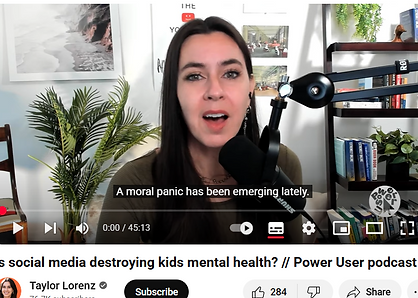
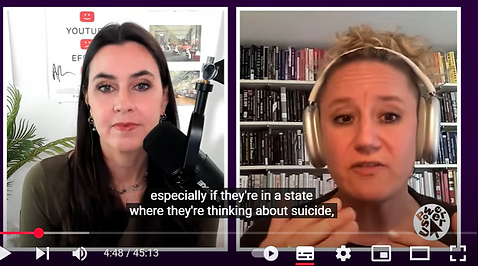

284 likes and 50 comments. When we first take a look at how this woman’s podcast is portrayed, she is giving a medium close-up shot facing the camera speaking to us with a bright background, that’s lots of plants and books and paintings/photos to indicate a very homely and peaceful setting. It makes the audience feel very comfortable. She doesn’t start off with an intro or any music but just get straight into it which I would not like to do in my podcast. I want to focus on having an entry rather than jumping into the video. She’s also very happy and speaks high-pitched with a cheerful voice; this is confusing to me as I would want to interact with my audience speaking in a tone that is serious and doesn’t give off a different meaning. She’s uses photos to back up her points which we haven’t seen any other podcaster do so far. She mentioned Jonathan Haidt who she states has driven the online safety app, as my audience and I are familiar with Jonathan we already can tell where this is going to go. She brings out her guest Danah Boyd, he spent 12 years studying young people and social media. She also has a website to support kids with mental health that are in crisis. This includes confidential messaging and support information. Taylor’s aims for this podcast are to talk about why banning these apps will do nothing, and what we can do to help the younger generation. Taylor starts off by asking the guest why mental health is all of a sudden popping up now the guest does remind her that this is a consistent flow and brings us back to the time where Covid happens and a lot of young people spent a lot of their time at home. They then mentioned how everyone expected everything to go back to normal after Covid but that didn’t happen and when the kids were going back in schools they realise there was a mental health crisis going on. A lot of my audience would’ve been affected by this or understand where this all came into play COVID-19 as a big thing that has affected the majority of peoples mental health; and I really hope I get to find out the reason of this so I can share this with my audience and my audience can fill better When thinking of this time. The next point start up on pick a different side of what my other frequent podcasts have taught us. This podcast the guest and the host both speak about how bullying suicide rates went down during Covid as people were online therefore people spending time online must be a good thing. I wonder if my audience will feel the same and feel as though Covid was a positive or negative impact on their mental health when using social media at the time. Understanding this I will make sure to ask this kind of question in my podcast for my guest to answers to see what she thinks about this. This point then leads into the idea that when these kids went back to school they hated it and when a child hates school, they don’t learn; their emotions all over the place and they don’t get the chance to socialise; which everything a child needs to do, it gets taken away. And when they start seeing the one thing that can give them all of their key benefits, as a bad thing and makes themselves feel bad. They will try and avoid it. And won’t want to go but when loads of adults are telling you to do something, it can make this child feel worse so what is it about social media and schools that can help children feel better. Was it all about Covid? Was that break from school? The reason why kids hate it so much or was it more to that? The guest Danah Boyd goes into explaining social media’s harms. When you have poor mental health. She states that when someone has a mental illness; if you expose them to media that says it’s okay to commit suicide, it’s okay to feel this way; it makes their vulnerabilities to go away and makes them see it as a norm. Then the less likely they’re going to get the help they need. It’s also mentioned that journalist take away the idea of “suicide” in their headlines because it makes people spike up, like whenever a celebrity dies of suicide a lot of people who copy that and suicide rates do go up so Danah is making the point that get exposed to this kind of media if you’re already in a vulnerable place becomes a toxic dynamic. This is helpful for my audience to know as a lot of them more software mental health and I feel like it’s my job to make sure that they are safe as possible so for them to understand these headlines and that a lot of people do get influenced by this hopefully it would stay them in the direction to not look at this kind of content online and therefore keep their vulnerability safe to themselves. The house then begins to speak about how she disagrees with Jonathan Haidt’s book on the anxious generation. Her guest mentions that she thinks he only believes technology as the greatest problem of all young people. She thinks that this is not true. She thinks it symbolises out that parents will feel anxious and many people think anxious but doesn’t actually resolve around why kids feel this way and it doesn’t give them the tools to focus on the struggles that are facing because technology makes things visible the things that happen in the world when people are struggling you can see it online in many interviews are not about blocking the things that makes invisibles but actually finding ways to help them. I think my audience will agree for most part because understanding that they want help rather than what the problem is caused by is much more important. Although I think they’re missing out the bigger picture of what’s actually happening as everyone that struggles with a mental illness struggles for different various and different things I think what Jonathan is trying to push is this idea that social media is a big cause of that and I think they’re taking away the wrong factor from this. My audience can benefit the idea of this being important to understand why they’re upset but it’s also more important for adolescents to gain information on what’s bad and what’s causing damage to themselves. In this case I will use this podcast as a debate direction rather than using it for information as I don’t agree with everything being said but I think there’s a big point in where my audience can see different arguments and different points rather than focus on gaining information on this.
The Very Real Damage That Social Media Does to Kids (link youtube)
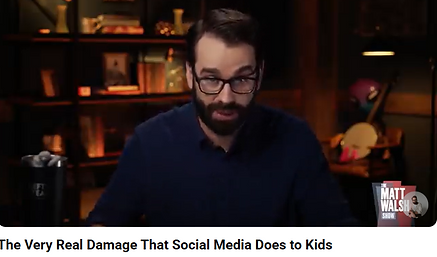
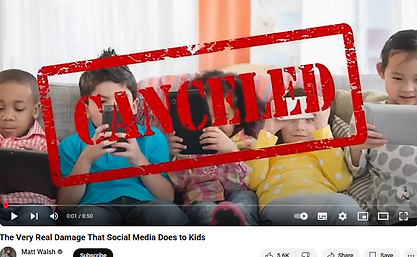
The podcast is 8 minuet long, which is a lot shorter than what I'm used too. Its also made with one host I will be having two people, overall I will be using the information provided rather than understanding the camera angles, this is because the video was made in one medium close up shot. 5.6K likes and 756 comments.
Starting off this podcast, there is only one host; that host is called Matt. Matt starts off his podcast with an opening themed photo of a bunch of kids on iPad and phones with a cancelled sign across it, the background has some kind of rock-punk music over it. This is the first podcast that has got music but I don't want to include the same type of music. For my podcast I will use ambient music but instead of this lasting a couple seconds I will have mine overlapping an intro that lasts up to two minuets. Matt is surrounded by a dark room lit up by a small yellow tint lamp, there's a chair in the back with different items on it, a bookshelf filled with items and books, overall this room feels quiet and homey like, the room is filled with a sense of comfort. The lights are setting the room at a dark pace, but there's also a bright spotlight facing the host so it brings awareness to the things he's saying. The host starts off by mentioning his own kids and how they grew up, he notices that they act like kids and love play; he mentions at the end how he knows many kids aren't like this. Already hes compares his kids with the rest in sense that kids need to play outsdie in order to be kids, thats the messgae my audience will takw from this and I feel like its crucial to mention that everyone grew up different buyt everyone went outside; so for me to express to my audience the importance of kids havinbg playtime.
the next point he makes is the idea that he would rather let his kids smoke cigarettes rather than be on social media ally day. This is crazy because most parents see that smoking cigarettes as one of the worst things to let their kids do. So by getting my audience to understand the issues and how serious this is, is important. In my previous podcasts I've written about, they mention social media as drugs or alcohol, and now this time a parent is saying its worse than cigarettes. I hope with the information I'm collecting I can suggest to my audience how serious these issues are and highlight these factors that parents are saying in order for my audience to be safer. The next point is the idea that kids cant find any enjoyment outside the screens, but they also don't find find much entertainment on the phone so overall kids aren't getting any source of happiness they just rely on social media to please them. This can make my audience feel quiet sad that this is the case and in some circumstances this information could change the way they view social media. In my past podcast it was mentioned that people don't scroll when they're bored its more of a continuous pattern. My audience will benefit from this because it pushes their knowledge of understanding why social media is so serious. Matt also makes a statement that he doesn't understand why kids as young as 8 need a cell phone; he states that parents will mention how they want their kid to be able to message them; but then get them a phone that only allows calls and messages no internet access and no social media. Matt states that there's not a single advantage for kids to have a phone and most of the time parents don't even want the device for the safety of the app but more for the idea of getting them to be quiet or to make them socially fit in. Matt then speaks about the idea of parents suggesting that no one will say "I wish my kids spent more time on their phone" no parent will say this so why is there a push to give kids a cell-phone so young. My audeince that are younger will think this is normal and fight against this because they beilive iut's socially acceptable; but my audeince who are sighltly older made begin to see the signs and realise how bad social media is currently harming younger generation. Overall my audeince will benifit from this because they understand the harms of what a parent would rather do to their kids over having social media. I thought this podcast was short and educational, it has some factors like the intro, his spoke about his own story (anecdote), what he would do as an extreme and also justifies the idea of what most people are doing and how its bad. I would have made it slightly longer and would speak about important factors like how to help the audience to achieve a better childhood for their kids.
My mind map of what I was going to speak about.
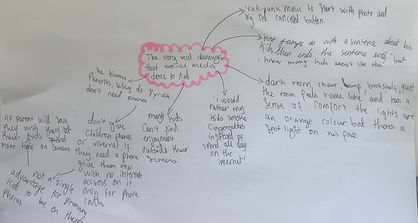
Why We've Become The ANXIOUS Generation & How We Can Fix It | Dr. Jonathan Haidt (link youtube)
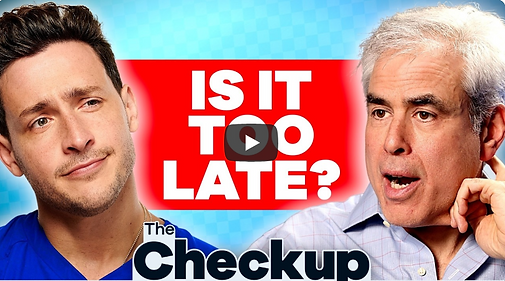
The podcast is an hour and 30 minuets long. Similar to my previous podcasts, Jonathan Haidt is a guest and this podcast is all about his book the anxious generation. There is also a help-line with number 116 123 for anyone to call if they need help. 14K likes and 1,757 comments.
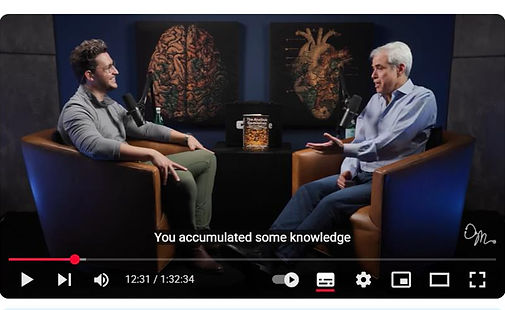
This podcast starts off in a dark room with blue spotlights, the host is by himself facing the camera. He starts off with an introduction that fades from black to the screen; he speaks about who Jonathan Haidt is, his books and what we will be expected to learn about throughout the podcast. I am getting information on the intro as I never know how to start. But taking this idea of introducing the guest and what topics will be facing is highly important and I think it will benefit my project a lot. When the host and Jonathan are with each other the room is dark with blue spotlights on them and their comfy chairs-- the chairs remind me of the therapist armchairs because of their shape, I will be using something similar. They both sit facing opposite each other with a medium shot length, although when they're together it's more of a close up shot. The book faces the audience to promote it to the audience. On the background wall, there are two different photos of the brain and heart, this is used for the audience to understand this will be on psychiatry. There are three camera, one on both people and one for the middle, this is how my cameras will be set up. And there are two mics on the table behind reaching to the speaker. I will have a table to put mics on so this doesn't apply to me. To start off, at age six Jonathan stated that our brains are at 90% growth so between 6 and 12 the brain doesn’t grow much, the time of 6- 12/13 this is the period where we have slow physical growth, but massive cultural learning. Jonathan states how we are the only mammal that has the ability to learn from each other. Overall, my audience would benefit from this from the idea of where our brains grown and how. The next point Jonathan speaks about is about puberty, in 1995 and before, kids grew up watching tv and most of it was fiction or educational, by the time 9’oclock came around; kids would have to turn it off for the adults tv to come on. After 1995, kids grew up getting random information from strangers whenever they want at any time. There is no shut off. Thinking about my audience I think it’s crucial to remember that my audience is in the phone-based childhood and for them to understand that there needs to be a switch off time is important. The issue is because this is a global world-wide thing there isn’t a set-off time where it shuts down, hopefully with this information I can tell my audience the importance of making your own screen time shut off. Thinking back to our brains and them developing we can tell that with Jonathan’s information millennials got to the age of around 20, where their brains have fully developed, and then went into the virtual world. Whereas a lot of younger generations like GenZ that dived into the virtual world straight after their brains started rewiring. This is important to talk about as most of my audience will relate to goring up with a phone-based-childhood and therefore understanding the study of these issues will help them set boundaries and be aware of these issues.
The next point Jonathan Haidt speaks about is about AI, and how it’s affecting the youngest generation. His point made was the different between watching movie fiction and interacting with an intelligent creature. GenZ didn’t really get a childhood because their early years of play was taken by phones, Covid affected their school experience, but they are the last generation that went through childhood without servants. As someone is GenZ I can determine the ideology that I personally did have a play-based childhood, but covid did affect my school experience as well as the idea that I grew up without AI. Any of my younger audiences will be living through this so to understand this is crucial so I can connect with my audience on a deeper level. It’s also helpful I speak about this so that I can get the idea of how to help the younger generation steer away from all this. Gen alpha will have so much Ai around them that it will seem unnecessary to speak with real humans. This can disconnect them from the world making it seem depressing. I want to share my thoughts with the audience on what this upcoming generation can do to steer away from all this harm. “Social media is new, and we will adapt to it” this is what a lot of people are trying to justify with Jonathan, but he announces how this is wrong. There is no time, he states that in two years all our kids will have so many Ai people in their lives. This is scary to think about as robots were seen as scary and evil, but now they’re surrounding children’s every move. I am already not a fan of ai, in work ethics its great, but to replace it as your friend is scary weird. That’s why I hope to share this with my audience and give them the realisation that this isn’t normal, and you shouldn’t replace social queue with something so harming.
Jonathan’s next point is about sending something among thousands of people when you retweet. The issue with this is when like and comment buttons come along which is where users are giving the platform so much of their information. This is serious because I want my audience to understand that they’re putting their whole life information onto an app that’s recording all this data. You wouldn’t share it with a real human so why share it to an app? The host asks Jonathan “what’s harmful in social media? Is it because of the influence? Or is it the virality of the platform?” Jonathan answers with multiple different answers all tied up to one reasoning which is about the harms social media teaches you. The first thing Jonathan speaks about is the idea of sexual activities online that most people don’t approve too. This already is scary and can destroy someone’s innocence or mental health. The next point Jonathan makes is the idea that if you were to take a healthy play-based childhood kid and then took away these things: friends, 30 minutes of sleep, outdoor activity and no sunlight- instead blue-light at night. And now add in chronic self-comparison, more bullying – that follows you wherever you go, attention fragmentation and addiction. You can see this would make a child lose its happy qualities and become depressed. I want to share this with my audience as they can learn and adjust from this because unpicking this all slowly gives the audience a bigger picture that they can imagine and realise these dangers. Jonathan states that people look at the big picture rather than all the smaller ones, e.g. social media (based on true survey of doctors) that only 0.2 of social media is affected by mental health. Which we think is small; but the amount of mental health harm caused by drugs and binge drinking, are also 0.2. we can see that there is some kind of correlation to these addictive mind control diseases. And I want my audience to understand how linked they all are together rather than focusing on the bigger picture.
The decisive point that the podcast made was this idea that there is an over diagnosis. More people posting this online of their mental health which is raising views. On apps like TikTok there are trends about the idea of everyone must have a mental illness. Kids look at this and determine that its ‘part of an identity’, this way people are now forcing therapists and doctors to give them a diagnosis which makes these doctors feel pressured. Its also stated that when a child is exposed to so much mental health damage online, they engage with this and copy these types of harmful behaviour that could end badly long term. Overall, my audience will learn about these harms so they can be aware of the harms to stay away from. Its also important for my audience to take care when on these apps sop the more knowledge, I think about the more I can share and help them. This way they will set boundaries for themselves and overall help the app become safer.
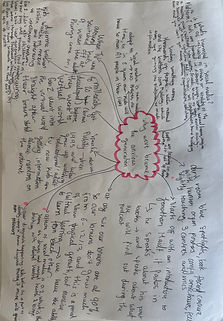
Research - Influence
Jonathan Haidt
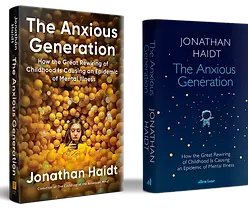
The first book in yellow is the first publishment of the book and is the classical American styled book. The blue book is the one that's published in the united kingdom. They both have the same information but altered slightly for those in different countries to understand in their language barrier
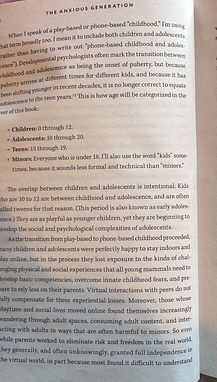_edited.jpg)
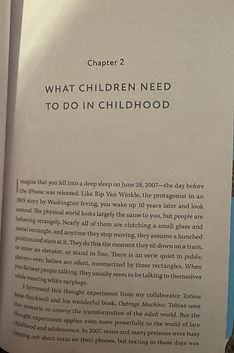_edited.jpg)
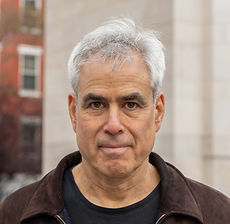
"Photo credit: Jayne Riew" - by Edmonds R
I first found out about Jonathan Haidt through other influencer's podcasts as him being a guest. As I dived deeper into who he was and what he does, I found he does lots of work on social medias reflection towards adolescent. Haidt has done 4 Ted Talks, and has a series of books. The book "the anxious generation" stood out to me the most. I first saw this book when Jonathan was on a Podcast with Jay Shetty. They both promoted the book and I grabbed the book from my college library straight away.
"Haidt received his Ph.D. From the University of Pennsylvania in 1992, and taught for 16 years in the department of psychology at the University of Virginia." This was stated by NYU Stern, in 2020 by Leonard N stern, School of business. NYU Stern - Jonathan Haidt - Thomas Cooley Professor of Ethical Leadership
Haidt is a great influence for this topic as because he is older he watched it all slowly unfold, And most people of his age turns a blind eye but Jonathan dived in deeper and highlights how important this topic is. That's why I'm talking about Jonathan Haidt in my project, is because of how brilliant his work is and how much time thought and prosses has been put into each piece of information.
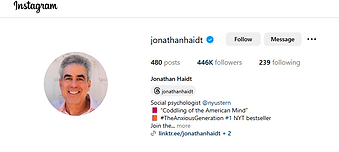
The Anxious Generation - Jonathan Haidt.
The Anxious Generation
How the Great Rewiring of Childhood Is Causing an Epidemic of Mental Illness.
The contents include an introduction: growing up on mars. Part one is called “A TIDAL WAVE” with the chapter being named “The surge of suffering”. Part two is called “THE BACKSTORY” which has the subtitle “THE DECLINE OF THE PLAY-BASED CHILDHOOD” the three chapters are “what children need to do in childhood, discover mode and the need for risky play, puberty and the blocked transition to adulthood” Part three is called “THE GREAT REWIRING” and the subheading of “THE RISE OF THE PHONE-BASED CHILDHOOD” there are 4 chapters to this part, they’re called: “The four foundational harms: social deprivation, sleep deprivation, attention fragmentation and addiction”. The second chapter is called “why social media harms girls more than boys”, the third one is called “what is happening to boys?” and the last chapter is called “Spiritual elevation degradation”. Part 4 is the final part, the title of part 4 is “COLLECTIVE ACTION FOR HEALTHIER CHILDHOOD” this includes 4 chapters called; “preparing for collective action”, “what governments and tech companies can do now”, “what schools can do now”, “what parents can do now”. There is also a conclusion at the end, educating on how to “bring childhood back to earth”.
Growing up on Mars, this chapter has information around understanding the age barriers and terminology which is highly important for my project because I need to understand the age terminology to speak about ages and generations. In the book it states:
-
Children are 0 through to 12.
-
Adolescents are 10 through to 20.
-
Teens are 13 through to 19.
-
Minors are “everyone who is under 18. I’ll use the word “Kids” some-times, because it sounds less formal and technical than “minors.”
Haidt states this because the upbring of tweens that chose to stay indoors and play online, are losing the challenging physical and social experiences that all young mammals need to develop, overcome fears and be independent. It's also stated that when young adolescents that move their playtime and social activities to online, they start to realise how they start wandering through adult spaces, consuming adult content, and interacting with adults in ways that can often harm minors. (Page 8)
This information highlights how important it is that kids have more time to play rather than spending time on screens. This is so helpful for research towards my project because Haidt covers all important details that I’m looking for. When Haidt stated about mammals needing true experiences; this made me realise how I can speak about the idea of other mammals in my podcast so that my audience can truly get that idea of you wouldn't give an animal a phone, so why a child? Haidt has so many facts and eye openers to why this topic is so serious, and they all correlate with my project. For my project I want to find out why social media is so harmful on adolescent's mental health and because Jonathan has made studies into what he thinks is the cause; I can reflect on that and produce my own content sharing his ideas.
In chapter one, Haidt speaks about when it started and the rise of social media and depression. There is a multiple of graphs that express where Haidt is coming from in terms of social media killing kids' mental health. The first graph I want to talk about is the rise of suicide rates for younger adolescents. The graph starts in 1982 and goes up two years until 2020. The ages of the people being rated are between 10-14; (source: U.S. Centers for disease Control, National Center for injury prevention and control). The graph also stated the rate at which per 100,000 population. The graph shows us that the suicide rating for girls began to rise in 2008, but from 2010 to 2021 the rise was increased by 167%. Whereas boys increased by 91% since 2010. Haidt also states the opening of smart phones in 2007, Haidt states how this all came in two waves, the first wave being in the 1990’s when there was a rapid increase in computers which were in most homes by 2001. Over these next 10 years there wasn't any decline in mental health, but it was stated that millennials that grew up in that period were slightly happier on average than Gen X when they were teenagers. The second wave was in 2012-2013 when smartphones developed and social media was developing; this is where girls' mental health began to collapse, and boys' mental health changed in sets of ways. Haidt believes that this is where the 2010-2015 great wiring of childhood happened. Jonathan states that the social patterns in children like role models, emotions, physical activity and sleep patterns were fundamentally altered over the 5 years. The consciousness of a 13-year-old with iPhones in 2013 was profoundly different compared to 13-year-olds that have used flip phones in 2007.
This is beneficial for my work because I can take away the ideas and stats that have been added to format my information when looking into where mental health spiked and if it's truly caused by social media. From this take on part 1 I can get a true understanding that Haidt believes social media caused mental health issues from the rising of mental health and social media being the same graphs of time. I can take this further for my project to really understand if this is the cause and explain to my audience because of these graphs of time you can get the idea that mental health sparked from the upbringing of social media, but if I further my research I can begin to see others opinions on this cause and work out that social media and mental health rised together because social media is what brought out the voices of those with these issues. Something I like so far about researching this is how Haidt explains his ideas with graphs and goes into full detail about the upbringing of social media and how certain kids reacted over time to these devices. I like this type of research because I can fully understand how Haidt thinks about this topic and how easy it is to understand it is. Something I don’t like about what I’ve read so far is that Haidt does repeat himself a lot and I feel as though he’s only focused on one end of the argument and could interpret how this might not be the case; because no one truly knows if social media has a real effect on mental health. What I would do to interpret this into my own work would be to use the graphs and explain the idea of this rise in mental health and social media at the same time but I also want to focus on the fact this might not actually be true, unlike Jonanthan Haidt, I will focus on making sure both sides of the argument are valid with backup information.
Part 2 of the book starts with a short first-person introduction of what it would be like to fall into a deep sleep on June 28, 2007, which is the day before the first iPhone was released. You then wake up 10 years later and everyone around you is quiet, holding a small rectangular glass; every time they would stop moving, they would hunch over and stare at it- they do this anytime they stop or sit down and a quote that stood out to me is the idea of there being “an eerie quiet in public places-even babies are silent, mesmerized by these rectangles”. When I read this, I felt chills; because when you highlight that sense of waking up to this norm be unknown, it can feel scary. To now imagine growing up watching the world almost go silent really does indicate how this could be linked with mental illnesses, and I think that's where Haidt was trying to prove. This is relevant to my project because I do want my audience to be able to connect with me and if I can feel to go back in time I can portray that into having some level of understanding how everything grew into place, the history of my project is just as important as today so by highlighting these scenarios that Haidt spoke about I can slowly indicate and pick out how someone feels growing up through it must have felt. As I read further, I picked out some scientific evidence that correlates with evolution. Haidt analyses the idea that evolution has provided us humans with an extended childhood because it allows us a longer period of learning the accumulated knowledge of one's society; a cultural apprenticeship, during adolescence before they shape into an adult. Furthermore, there's also a statement written about the studies on young rats, monkeys and humans that show young mammals want and need to play in order to be socially, cognitively, and emotionally impaired. If young mammals excel in these skills, they will learn to be successful in adulthood. Overall so far this has got my attention because studying into this idea that we are like mammals and we need similar skills and ethics in order to succeed, when you give a child a phone it exposes them to far beyond where their learning should be; same if you was to give a phone to an animal it wouldn't understand or use it. The idea Haidt is trying to pursue for us is that children need to play outside and have harmful real experiences in order for them to survive in the real world as an adult. And I think this is crucial for my project as I can take that idea of a child to an animal and create a better understanding for myself, to gain knowledge on the damage caused to children by phones.
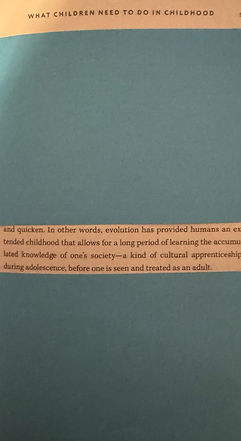_edited.jpg)
Jonathan Haidt - Instagram posts
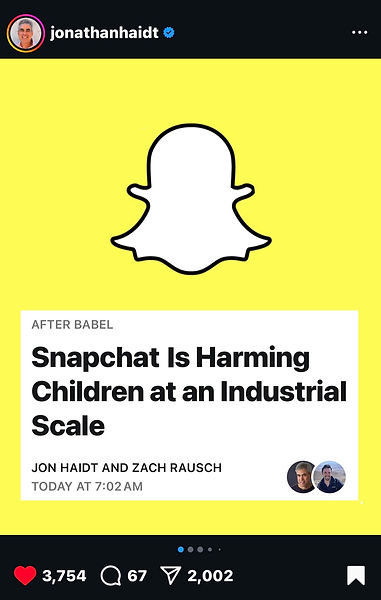
Instagram post site:
https://www.instagram.com/p/DIh1G1TuOn9/?igsh=Z2xsOW9ydWdudmJk
Jonathan Haidt's Instagram page is filled with lots to do on adolescence for social media. He posted this on the 17th April 2025; this post consist of 20 slides. On slide 7 there are three different bullet-point slides that states:
-
45% of snapchat users 13-17 use snapchat almost constantly.
-
41%of snapchat users 13-17 use YouTube almost consistently.
-
34% of snapchat users 13-17 use Instagram almost consistently.
Another slide states the idea of drugs and drug dealers. Snap employees reported that drug dealers were finding their buyers through the quick add feature. Stated that on average at least 700K snap-chatters are exposed daily to drug content.
Many people, believe snapchat was made for "sexting", over these past 10 years; "sexting" and nudes have become a common behaviour across many age demographics, Generation Z has the highest of regular behaviour among sexting. And we know it happens on snapchat.
Haidt also exposes that parents have stated that they believe snapchat encourages their teens to behave without consequences and enhances cyberbullying, contact with strangers, inappropriate behaviours such as sending or receiving nudes, sexual explicit images, messages or videos.
Haidt explains that snapchat can fix these issues. He speaks about 6 ways snapchat could change in order to be safer for adolescents. These are:
-
Work harder to identify underage users and remove them from the platform. Haidt explains how there are at least several million under 13-year-olds having snapchat accounts; which means that social media should age gate in a verities of ways.
-
Remove the quick add feature. This is Haidt's main concern as he states because quick add is the most affective way for predators and drug dealers get access to children and teens.
-
Remove the streaks feature, Haidt has spoken about this in many podcasts because he believes that this is the most effective way for kids to be on phones on this app everyday. He states that teens shouldn't need to compulsively sending photos to each other increasing the their time on these apps.
-
Remove beauty filters. Haidt hasn't written anything below this but from my take, and what he's said before, the idea of adolescents not being comfortable with their own face and needing filters will bring down their confidence and be prone to bullying or anxiety.
-
Remove engagement-based algorithms. At first I was confused by this so I looked on the website: How the Snapchat Algorithm Works [& What the Emojis Mean] | Tinuiti when looking through this I saw the ideas that if you buy premium for £3 a month then one of the features are to do with seeing your friends "best friend list". This can be upsetting for friends among school age group as jealousy can come in. Haidt states this should be removed at least for minors.
-
Stop deleting posts on Snap's own servers. Haidt exposes that snapchat doesn't store the content of conversations meaning drug dealers, sextortionists and other criminal intent can go on their day without any record of what's being said. So if something goes terribly wrong, their conversations cant be discovered by law enforcement officers.
The stats Haidt chose for his points are helpful to my project because they give me an insight to how many snap chatters are using other apps and because I don't use snapchat I don't know much on this so Haidt's research is helpful so I can see anything that's necessary.
Finding out about the drug dealers tactics and podophiles secret. Is scary but I also find this a great research plan and the information stated is highly efficient this is because I can tell where the harm is and how this has come around. Overall the information is important to my project because I can now get a sense of where others can harm kids.
For my project I want to get to the bottom of why social media is so harmful for adolescents mental health. So this piece of information is useful because I personally don't use snapchat, I was banned and since then never wanted it back. Since then my mental health has improved. But because I cant look at all these new issues I go to the internet. Haidt's points were so crucial as I got an understanding of what is wrong with snapchat but also what Haidt thinks we should change for this to improve. All of his points were on point and gave me an understanding of the dangers I never realised. Something I like about this is the way Haidt explains what should be done in order for snapchat to be safer for kids. I liked this because I can refer this into my own work by speaking about the idea of snapchat deleting their history. I will talk about how unsafe it is to not record these messages and speak about the harm caused or could be caused by this feature, something I don't like about this is the fact that Haidt hasn't used any information or anecdotes to back up these points. For my own work I will take away these points but I will also further my research into finding proof for this. Overall this piece of information is beneficial to my work because it helps back up more with the question what could we do. Which is a big question for my podcast.

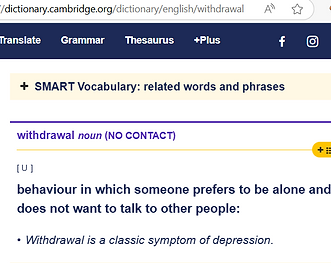
Jonathan Haidt re-posted this post onto his story. Already we can tell something must be important because Jonathan must relate to what is being said; when someone speaks on behalf of their own work it can feel biased, but Haidt reposting others peoples content highlights how he must think this post is valid and suitable enough for him to re-share. On the left is the screenshot of Haidt's Instagram story of the post. The post itself has 6 different slides; Haidt chose the third slide here. The slide consists of "8 signs that your child may have developed a dependency on screens" the eight different slides include of:
Loss of interest in other activities. Personally I could see why this would indicate towards mental health; because the first sign of struggling is losing the ability to enjoy activities that were once loved. This sign could be an important part of my project because understanding the connection between mental health and social media is a highly important task for me in order to produce my podcast. For my project I am trying to understand social medias harm on mental health and when I see posts that indicate social media and what its doing to kids, you can link the symptoms of mental illness' with these signs. To follow up with more detail on what I mean, I've researched into depression symptoms on a website called: Teen depression - Symptoms and causes - Mayo Clinic
The next sign is "falling grades". In the UK this wouldn't be the same thing as the US, because in America the students are all about grades; rather than here in the UK where there is mostly only one main test at the end of the year. So my take on this, if this was set by UK schools, I would convert this to lack of effort in class. Usually when adolescents don't put in the effort in classes, they either don't want to be there because they're bored or something much bigger is going on and they cant focus on anything but that. This is why I think this Instagram post is so valid for my project, as I understand, that when kids aren't paying attention it's much more than school in their mind, because I was in that position; so that's why with my project I'm going to show people these signs so they can look out for others. I will take away the knowledge from this post to help push further my education and be able to preform a podcast that is as inspiring as what I'm researching about.
Another sign is "Isolation". this sign is a quiet pain killer, I say this because in the movie "adolescence" there was a scene when the father said "but he was in his room, weren't he? -We thought he was safe, didn't we" This sign being isolation is scary because it brought me back to that series, where everyone got the idea of if you were in your room alone then you cant be hurting anyone. Unfortunately isolation can make people much worse, so seeing isolation as a sign really brings my project together and will hold down the information of why this is so serious. The more everything unfolds together the more I can take in the research and produce content that's understandable.
The forth sign is "Aggressive behaviour". Like-wise with the first sign, this also compares with the same type of symptom as depression. In depression it's often that the person suffering will show signs of "irritable or annoyed mood", both of these are incredibly similar which relates back to the idea that depression and social media is linked. This is useful to my project because I'm getting knowledge from the similarities of symptoms which leads me to a wider branch of information that I can use to my advantage and create my podcast with multiple different backed-up facts.
The next sign is "mood swings". Although mood swings are common during puberty, it can also be quite dangerous. A lot of adults pass off mood swings as a part of hormones and puberty but the issue is when those mood swings become intense emotions and even more rapid mood swings. It is completely normal to get mood swings during your teenage years; but its not normal to be in an intense emotional state 24/7. By 'emotional state' I mean sadness, anger, jealousy, happiness and every other emotion that you feel. This sign is important for my project because my audience can get information from this an interpretive this into their own examples because I will highlight the important factors and my audience will be able to share and connect, hopefully understand what I'm saying to spread the word so others can get the help.
The 6th sign is about "increased conflict with family members". This one is hard to tell what the cause is. Because even though someone spends a lot of time on social media we don't know if that's the reason for lashing out at home. A child could have family issues or a mental illness and even though parents always blame the phone it isn't always as it seems. A child will be influenced by what they see online. If they see angry people they become that. And the point I'm trying to make is that this will benefit my project because my project will solve the mystery of if its the child and their own issues, or is it the phone that's influencing these. My audience will take in this information and learn to understand these signs for the future. If anyone does notice these signs they will know to take action therefore saving someone's life.
The next sign is "withdrawal symptoms". When I was searching further into what kind of withdrawal symptoms this could speak about. I found a connection with: WITHDRAWAL | English meaning - Cambridge Dictionary. Cambridge Dictionary stated how withdrawal is a side-effect of depression. This is because Cambridge's idea of withdrawal meaning to hide away and be alone traces parts in depression. This also ties into the idea of isolation; which is also a common factor in depression and other mental health illness's. My audience can take away a lot from this because when I portray this information they can understand the correlation between social media and mental health and see how in-sink they are.
The last sign is about "hygiene concerns". I know that lack of hygiene is a common symptom with poor mental health but I wouldn't see how phones are connected. My take on this would be the idea that kids spend so much time on these devises that they don't care about important daily activities, or when they're on these apps/games they begin to lose track of time which leads to tiredness and then they "can't be bothered" to keep their hygiene fresh.
This issue I personally think is rising and schools need to teach kids to get back into that hygiene routine. Hopefully my audience can reflect with this and understand the importance of hygiene, I hope the also connect and share this on so there's more of an awareness on the importance of hygiene.
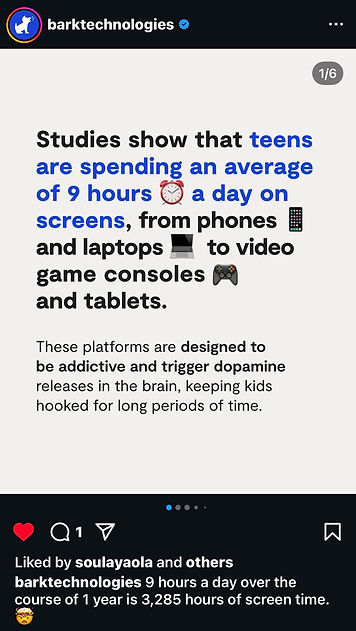_edited.jpg)
Teen depression - Symptoms and causes - Mayo Clinic This website gave me a list of both emotional and behavioural changes that a teenager will act on when they're showing symptoms of depression.
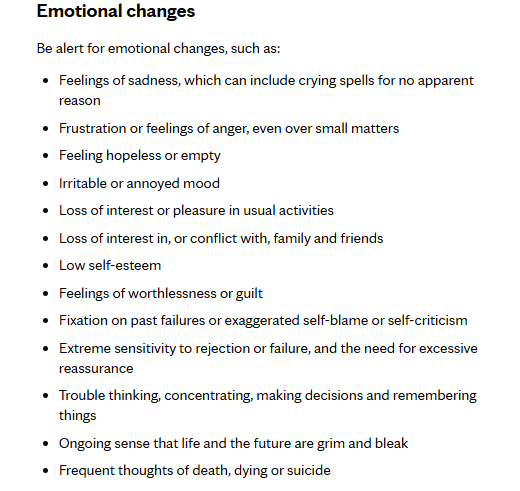
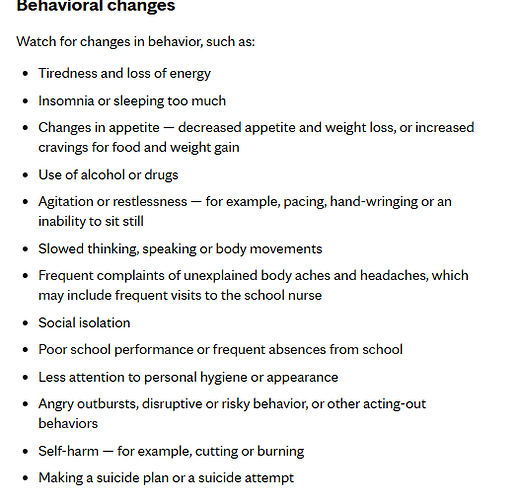
Understanding that a lot of the signs shown are the same or similar to the symptoms of depression. Here I've found a site that lists all of the emotional and behavioural changes that happen during depression. All these symptoms are important because we get to highlight how internally that person is feeling but we also get changes in behaviour which helps the audience get an idea of what psychically someone might act like when going through depression. I understand that by talking of this my audience will also understand what actions teens are doing that indicates they're struggling. The more people are aware the more the ones struggling can get help.
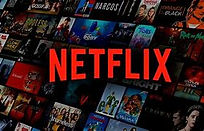
photo taken from:
Recent Trends
There are many things to do with social media right now on Netflix. Netflix is a big streaming platform, with over 300 million paid memberships and spreads across 190 countries. Netflix is known for its TV shows, movies, games and all types of genre's. I thought Netflix would be a great form of media in recent trends, because, all ages watch Netflix and it's most common among adolescents. My audience would know about Netflix, I know this because the site: Netflix users by age in the UK 2018| Statista explained how it's reported that 15-34 year olds stated they watch Netflix weekly. Because Netflix is so big and common among my target audience, I feel as though this is a perfect example for recent trends.
--(edit-5days later came across)-- Spotlight on the digital 'manosphere': When to show dramas like 'Adolescence' to kids | Watch
this link shows a news video of an inside feel of how dangerous the media can be. This news article/ video was extremely beneficial for my project because the two trends I have began to speak about, are being mentioned together later on. My audience can really benefit from this because they can see from another reporter these dangers and the more this gets spoken about, the more we can become aware to these scary, serious issues.

Both these Netflix shows were made in this past year. I have chosen these because they both show struggles of kids and teens that are involved in social media.
Adolescence and Bad influence
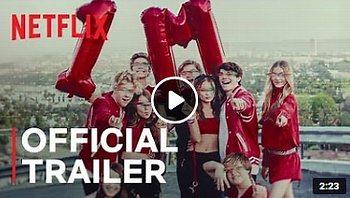
photo taken from: https://www.heavenofhorror.com/reviews/adolescence-2025-netflix-series/
screenshot taken of start of video:
Adolescence
Research on adolescence
To highlight why I chose this Netflix show as research, this is a quote stated by: Netflix's Adolescence: 8 Eye-Opening Lessons To Learn From The Drama Miniseries | HerZindagi
"The series highlights how social media and the internet can expose kids to toxic content, unrealistic beauty standards, and harmful ideologies. It’s a reminder for parents to stay vigilant about what their children are consuming online"
This indicates how important this Netflix show is for my project as I hope to give out the same message with my podcast but in a peaceful way.
Adolescence was realised on the 13th of March 2025, and started to go viral a month after; it has reached a total of 130.2 million views and 499 million viewing hours, making it No. 3 on the Netflix chart of their most-watched English-language series of all time. Adolescents is split into 4 episodes and was shot in only two takes. In the first scene police raid a family (called the Millers) home, they storm around at 6am trying to find the teenage son Jamie. The rest of his family, mum, dad, sister are all worried, confused and they all scream and shout. Jamie gets arrested at 6:15am for suspicion of murder. Jamie gets taken into the station for questioning but denies everything and insists he's done nothing wrong. Jamie, and his father are both shown a video, of a boy hooded up with blue and white trainers on; following a girl into a park and stabbed her. The story was apparently based on a true story which happened by a 13-year-old boy in Croydon. The link I found this on was: Netflix's Adolescence inspired by true story of Croydon girl's horrific murder - Surrey Live In the second episode, the police want to find answers and evidence so they go to Jamie's school. Jamie's friends and classmates don't say anything about it, until the police officers son comes in to help as he went to their school. They find out that the knife used for the stabbing was one of Jamie's friends from home; but Jamie's friend insisted that there was no intent for using it. Episode 3 is the main episode that social media comes into play. Jamie meets a psychiatrist because he's been put into a psych hospital as he was too young to be in prison until further detail is proven. The psychiatrist gives Jamie a hot chocolate and a sandwich that has cheese and pickle. Jamie stated he Hated cheese and pickle, he still ate it. This could indicate how he lied during the interview because he "didn't do it" just like he "didn't like pickle" yet he still ate the sandwich. The psychiatrist asks lots of questions around Jamie's father and Grandad; Jamie gets confused by this and feels as though its an attack on his dad. This part represents dramatic irony, as us audience's can tell that she is asking Jamie these questions to be able to see if this is a behaviour linked pattern within the family. I watched episode 3 and created a Mind map for the questions Jamie was asked, Firstly Briony (psychiatrist) asks questions about his dad and grandad. These questions include things like "is your dad friends with women", "what kind of man are they?" "Does your dad like his job" Jamie replies with " he fixes toilets, what do you think" in a sarcastic manor. Briony asks Jamie if his dad "is funny", Jamie replies with "sometimes", Briony then asks Jamie if his father is "loving", Jamie pulls a face and replies "no that's weird", "angry?" replies briony and Jamie answers back "suppose". Briony asks Jamie "how angry does he get" Jamie replies "he's never hit me".. "he just gets mad we all do".. " he pulled a shed down once-- when he was in proper rage" Jamie states how he thought this was all funny at the time but does mention how his father never hit his mum. Already from this we can tell Jamie's family isn't perfect. We also can highlight the idea that Jamie looks up to his dad and share that same anger. Briony asks Jamie "what being a man feels like" Jamie was confused by this question so Briony asks other questions to get around this idea but in a sense that Jamie will understand. "Do you have any mates that are women" Jamie replies "no", "are you attracted to women" Jamie replies "yeah, I'm not gay" "would you like a girlfriend?", Jamie says "yeah who doesn't". This is when the questions get more intimate and go into deeper context. TW: mentions of sexual activities. Jamie states he saw 2 girls in his year topless. Briony asks Jamie if these girls would want Jamie to see them but he replies with "everyone else did". Briony asks "what do you think is the normal amount, for someone your age would do sexually with a girl or boy" Jamie's says "I don't know, touching. Kissing" "what do you mean by touching" asks Briony and Jamie replied "touching her bits.. her chest, her backside.. Her vulvar" Briony asks "so you think it's normal for a 13-year-old heterosexual boy to engage in touching of a girls chest and her backside. Above or below clothes?" Jamie replies "below, maybe, above mostly". So far we can take a lot away from this; most young teenagers now, because of social media, understand these things and are engaging with them. This has spiked up recently over the past years, as most 13 year olds wouldn't be diving themselves into the idea of sexual intercourse; but as this series portrays that most kids now do get involved in this. Jamie says "I've actually done all that, touching and kissing" he further carries on by mentioning "I've had two girls show me their tits-chest.. I touched them and one of them touched my knob" so far we can tell that Jamie believes this is common and normal. We can tell by this that Jamie's family don't know about all this and haven't spoken to him about these kind of dangerous activities. This also represents how we need to talk with the younger generation about issues like this and safety online. Jamie states that the pictures got leaked around school "snapchat". Snapchat is an app where you can send photos or messages and they will delete straight after. Briony asks Jamie if one of the girls was Katie. Jamie starts getting worked up asking her how she knows this; Briony ignores this question and asks Jamie "how did you feel, did you like it" Jamie stated it made him feel good, and he liked it. Briony asks Jamie "were you attracted to Katie" Jamie states she's nit his type because she's "flat" and everyone in the school said it so it wasn't bad. This is so harmful and messed up for a 13-year-old and this is why we need to speak with younger kids and drive them away from thinking like this. Briony speaks with Jamie about Instagram. She asks Jamie "why do you have an Instagram account?" Jamie states that its because he "needs one" Briony furthers this by asking why, Jamie explains that "you cant look at other peoples accounts, if you haven't got one", Briony speaks with Jamie about why he "follows lots of women-- models" Jamie admits to this. Briony asks if he thinks "girls are attracted to you" Jamie replies with no, because he's "ugly". Going back to social media, Instagram gets brought up again but this time Jamie is asked to describe emojis. The emoji is of a kidney bean and Briony asks Jamie what he thinks is meant by this. Jamie states that "Katie is pretending I'm apart of those truth groups, they say women don't want us and don't care", Jamie also uses the word "incel" which is equivalate to lack of sexual experience. I found this piece of information of word meaning on the site: What does the term ‘incel’ mean? | CNN. Jamie then states that there's this thing called 80-20, which is described of 80% of women are only attracted to 20% of men. Jamie states that he believes this is true. Briony explains that "Katie commented on your photos quite a lot" Jamie explained that said he asked Katie out after her photo got sent around because everyone was calling her a slag and flat; she would appear more weak and therefore go out with him. Unfortunately Katie didn't agree and she laughed and told Jamie "she's not that desperate". Jamie furthers this by explaining that on the night she was killed, he didn't touch her he says intimating and scarlessly "that night I didn't touch her, I could've , but I didn't, I could've touched any part of her body if I wanted to, but I didn't. Most boys would've touched her so that makes me better- don't you think so" Overall this conversation brings up the idea that young kids nowadays sees girls as less than what they are and they will chose to follow others instead of sticking up for what's right. At the end of this episode Jamie shouts "do you like me" to Briony, he didn't mean this as a romantic way but more of this sense that Jamie doesn't like himself and he wants others to like him soi he can feel more validated. So understanding who likes him and who doesn't rules out the self hatred and will turn that against that person just like what supposedly happened with Katie.
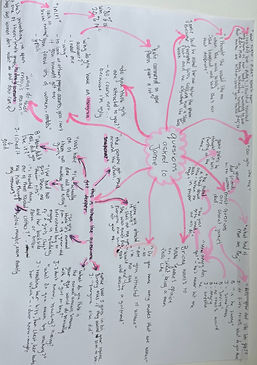_edited.jpg)
I started a mindmap while watching the seiries as I can add important detail and understand where I need to keep my focus and the topic that will benifit best for my podcast and audience.
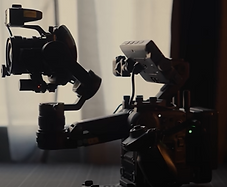
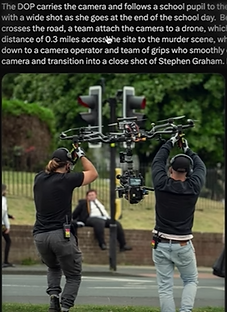
Codes and Conventions
Camera angles and techniques
Adolescents was recorded in only 1 part. I may have mentioned it was 2 but after researching more into the topic I realised it was one. They had scenes where they would have to throw the camera out the window to the next person.
This is the camrea they used to film the whole production. (Ronin 4D camera). When thinking about camera angles, I started researching into what the shot types are in adolescence. I came across this video: The CAMERA that shot ADOLESCENCE!. This video states the idea of old history and what's happened before. He speaks about Alfred Hitchcock's movie Rope in 1948, this is one of the first films made where it looks like it was filmed in a single take. But at that time of the movie there were limitations to film reels. Another movie director Alfonso Karon, took it further with children of men, the car ambush scene shot in a rigged car with a remote operated cameras.
To hold up that constant shoot Netflix made a comment addressing that any crew who would be in shot wore costumes to blend in and camouflage from the camera. There was 320 teenagers playing school kids, 50 adults playing parents, shoppers and teachers. The website: How Is Netflix's Adolescence Filmed? The 'Raw' One-Shot Technique Explained | HuffPost UK Entertainment announced that Barantini told The Guardian: “When the episode starts, my cinematographer Matt is holding the camera. As we’re filming the actors in the car, the camera’s being attached to a crane. The car drives off, and the crane follows." This indicates how powerful the cameras are and this idea of the camera being attached to a crane is something that doesn't usually happen very often. In some cases a crane shot is a perfect addition. A crane shot is adjusted by a camera mounted up onto platform, which is connected to a mechanical "arm" that can lift the platform up to achieve the end result. in some cases a larger crane could indicate to need both a camera and an operator, but others are moved by a remote control. Everything you Need to Know About Crane Shots - Armquest Industrial Services helped me understand the differences of these shots. Scarlet Empress (1934) or The Adventures of Robin Hood (1938). Both used crane shots, In 1958, Orson Welles used a crane to film the long take opening sequence of Touch of Evil, Wim Wenders’ Wings of Desire (1987) uses the Louma Crane to great artistic effect. I found out about these films by the website: Columbia Film Language Glossary: Crane Shot.
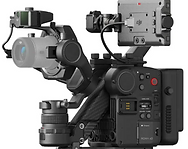

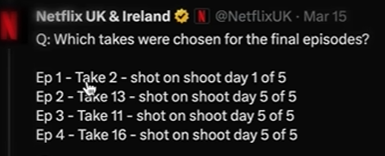
Location/ setting
Adolescence was filmed in Pontefract - City of Wakefield (West Yorkshire, England) I discovered this by the website: Here's Where Netflix's Adolescence Got Filmed: Locations & Towns In the UK
It was stated that the crew spent around six weeks building the set for adolescence.
The studio was an empty and echoey 14,500 square ft (1,350 sq m) which is just as tall as a four-storey building, some of the most crucial scenes in Adolescence were filmed in a wooden box named Studio 005. Crews spent six weeks here building important sets like the police station and young offenders institute (small mental hospital for trial period). I found this information, and more on the website: Inside the Pontefract film studios where Adolescence was made - BBC News this website also reported what the facility's head of production services, Richard Blair said about the production site "Me and my colleagues would walk around with the artistic director and get lost - we were transported into a completely different space." It's so crazy to think about seeing these life-looking spaces all in one place. I want to give my audience the same feeling of being in the 'movie room', as the scenes make everyone in this movie, watching or production, feel.
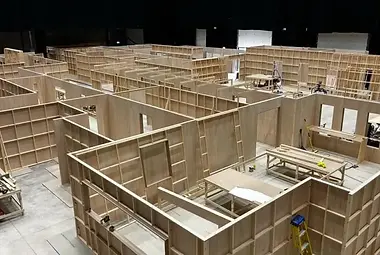
Lighting
Lighting was tricky, because you would assume all the lighting would be natural but after researching and finding out about how it's filmed and how the setting is. I realised this cant be the case. So I researched into it and after no luck anywhere, I came across a website: Inside Adolescence: Netflix breaks down episode take counts and the making of the drone shot. This website stated that there was real-time lighting adjustments, and there were methods made by the crew to re-adjust the lights "dynamically" on longer takes, without changing scene.
I then came across a video that showed lots of photos about the production; so we can look at the lights and figure out how they were fitted. Bing Videos.
The first photo looks like the lights they used while working on the building. The rest of the lights looks like were built into the space rather than spotlights.
The parts filmed outside were filmed with natural lighting; because it was all filmed in one take there was no need for waiting on weather or sunlight.
Music and sound
I found a site: Exclusive Interview: Crafting the Groundbreaking Sound of Netflix's "Adolescence" | Production Expert that spoke about the software used during post-production. They stated that the Splice sound team, created a list of what they use: Sound Radix Auto-Align Post, this is used extensively for "phase alignment", between booms and radio microphones. practical for managing overlapping dialogue and maintaining spatial coherence. FabFilter Pro-Q this was apparently the EQ plugin of choice. iZotope RX used for surgical noise reduction and cleaning up location dialogue. Accentize Chameleon, a reverb plug-which can mimic reverbs from any space. which is particularly used to generate impulse responses, taken from the boom mics, to replicate and match the acoustic space. Audio Ease Altiverb 8 XL. Used for immersive reverb design and spatial placement, particularly valuable for 7.1.4 Dolby Atmos output. The Cargo Cult Slapper which is used to create realistic echoes and slaps. Especially used on interior foley. Nugen Halo Up mix. This gave the ability to take mono and stereo sound sources, and up mix them to a more immersive 7.1.4 format. Oeksound Soothe2 was added towards the end of the mix, to do a final mastering pass of the dialogue - softening any final tonal changes. Youlean Loudness Meter Pro. Avid Pro Tools Ultimate they used a two rig setup in the studio, allowing both to mix at the same time. Making full use of the inbuilt Dolby Atmos Renderer, enabling to reference the Dolby Atmos mix as well as 5.1, stereo and binaural downmixes throughout.
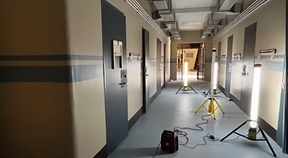

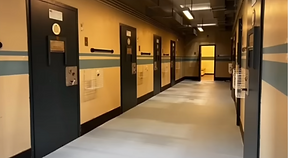
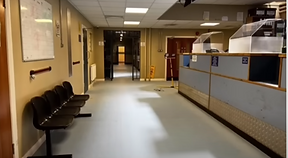

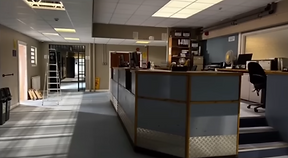
Why adolescence is relevant to my project
The links I used to find information on the key issues are: Adolescence: The key issues explained | Incel culture | The Mix
and the information on the emojis are: What do the emojis mean in Netflix's Adolescence? Icons explained and
Incels and red pills: The terms in Netflix's Adolescence, explained
💊
💯
🧨
🫘
I chose adolescence as a recent trend because it highlights the sad truth of the internet. The show consists of lots of key issues that we face in the world today. These consist of Misogyny, this is where someone has a hatred for women. The common signs for this type of behaviour are usually Verbal abuse, Discrimination, Gaslighting, Stereotyping and Violence. In adolescence this appears when Jamie's misogynistic ambitions lead to the murder of a female school friend. It's also mentioned that a UK report found that online, extremism is currently on the rise within young men related to incel culture. Incel comes form the words involuntary celibate; this means unable to form romantic relationships; there are lots of online community groups that are sharing their struggles together, but there's also a side to this community that turn violent and create negative attitudes towards women or society. So far my audience can understand and connect with this as they're in the generation that this is on the rise. By taking this idea of incel and misogyny issues into my work I can focus on creating content that inspires the audience to steer away from these issues and remain safe. Another key issue that's been spoken about a lot during the show was the word manosphere, this word is much more worrying and harmful side to incel culture, this is connected to communities around hate crime aimed for women; another influence for this would be Andrew Tete, who reports on women's hates online and is currently being investigated for rape and trafficking in several countries. The last key issue that relates most with my project is the emoji meanings. Firstly there's a red pill, this pill indicates manosphere, which is a toxic corner of the internet surrounded by toxic masculinity-- where boys and men bond over misogyny, blaming feminism for their problems and believe women should be submissive. The second emoji used is the 100% emoji, now this emoji represents the 80% - 20% meaning 80% of women are attracted to 20% of men, so if you're not in that top 20% as a man, the only way you can "get a girl" is by manipulation. Another emoji used, by Katie is of a dynamite, this can mean the exploding red pill, meaning that someone is an incel. The next set of the emojis are the hearts, apparently according to Adam in the show, Red means love, purple means horny, yellow is 'I’m interested, are you interested', pink - 'I’m interested but not in sex', orange - 'You’re going to be fine'. Lastly the final emoji is the kidney bean, this ties in similar with a trend that went around of men commenting "(women ☕)" which was used to down-grade and belittle women. But the kidney bean also faces that it is a self-identity to identify being an incel. Overall these factors alone tie together why its such a big issue for kids to be influenced by these things, and with my project and podcast I hope to advocate and express this so that my audience can feel safer online and understand what to look out for. After watching adolescence you get the sense that everything online has a meaning. By researching this and using the ideas of emojis, the harm and the viral fame that's swarming around this show with be so great for my audience as, 1- more views because of the fame going around, 2- more people will be open to discovering about harm and will have a better job understanding, 3- I will be able to teach kids about the harm while also understanding their language and how they feel when it comes to these topics. I will use the danger that this show has warned us about in order to create my podcast that influences kids to do the right thing and make better discissions, another factor I will pay attention to is the idea of kids thinking their so grown up. In many parts of the show you can tell these kids think they're a lot older and mature then they are. This is portrayed mostly with the online content they all share, but also the way they act and talk with adults, there's no respect as if they're all the same age. This is another worry about this generation that I want to try and cover during my podcast. This way my audience can get an ouside view on what this is like and how harmful it really can be. I also want to be able to connect with my audience in order for me to be able to change their negative thoughts, so creating a relationship is a big factor. Which is why understanding these details are highly important so that I cant get lost behind or not understand the new genertaions language or social media barrier. Furthermore I hope to use this show to get an understanding on how to connect with my audience, but also share that harm that is going on right now that they will be able to understand and connect with.
❤️ 💜
💛
🩷
🧡
Bad Influence - the dark side of kidfluencing
Research on bad influence
Piper Rockelle is a young social media star who made videos on YouTube since she was 9 years old. Piper has over 12million subscribers on YouTube; she has over 6million on Instagram, and 14million on TikTok. At only age 17. The documentary was split into 3 parts: #Momager, #crush, #unfollow. They were all 45-52 minuets long. The documentary started off stating some news articles, that were NBC News: "a YouTube stage mom faces abuse allegations from 11 teens in court case", there was another article from Los Angles times: saying "in the block basher law suit threating one YouTube stars multimillion dollar empire" Fox News: stated "teen YouTube stars mom boasted she was 'pimp' making 'kiddie porn': 22 million dollar lawsuit.
It all started when 11 teens stated they were exploited, working over 12 hours everyday. The kids stated that Piper Rockelle's mom "Tiffany put me in situations where I felt unsafe," one child, sawyer stated that "we were told to do things that isn't really alright for adults to be telling kids to do." Sophie Fergie who was pipers old best friend said that "they made it seem like a fun happy house, when it's really a house of horror." Tiff allegedly yelled and screamed at everyone. The mother of the children from the squad stated how this place was like "a cult- you cant get out". Piper was born in 2007, her mother Tiffany was 26 years old, her dad left when Tiff was pregnant. At 3 years old Piper started doing pageants, Tiffney's sister stated that Tiffs drive for pipers success is to show pipers dad she's worth something and he's missing out. Piper was doing spray tans, makeup, hair and she practised doing pageants everyday at such a young age. Piper loved the attention, but Tiff wouldn't stand for second place. When piper turned 6 she moved to Musically, this was a 13+ social media app where kids would make videos of lip-syncing to songs. Everyone mentioned how comfortable piper was in front of the camera; in 2017, she went onto a show called Dance Twins, Piper always wanted to please her mom and when she started taking off, after dance twins, her and her mother moved to LA to take off their career in media. Piper met Corrin during dance twins and made their first YouTube video together. Which got over a million views almost instantly, Piper had this man who would film and edit her videos; he was seen as her brother online, which we later find out was secretly with Tiff, he was 19-20 at this time. He moved into their house. Piper goes onto a show called MANI by BRAT, which was a nanny who was a man. This is where Sophie and piper meet to become friends. During one take of the show, someone from that set got more lines than piper, her mother Tiff didn't like this and screamed at the staff announcing how "piper made this show she needs the most lines," Tiff told Sophie and piper to come with her but Sophie refused. Piper and her mom stormed out not to return that day. Sophie stated this took a toll on their friendship and Sophie stated this is when she realised "Tiff was unstable, and you had to watch what you say around her". Tiffany's sister stated that when their parents got divorced, this took Tiffany into a different light by becoming more abusive and angry, psychically, verbally and mentally. Her sister decided not to talk with her anymore. This is when the squad started to form. Lots of older youtubers started this and Tiff found the perfect opportunity for these young kids, she knew who to look for; she found kids that wanted to be famous. Tiffany sends Sophies' mother an apology text and invites her back into the squad as Piper misses her. Since the squad got together, these kids were making in total six figures a month. The captions on their YouTube videos would say things like "crush" "kiss" which drew older men's attraction, some videos were 92% male viewers. This is really harmful for 12 year-olds to be put through. Piper told Sophie she wanted a stable parent that wasn't only there to make videos, Tiffany was always known as the "cool mom" Piper always viewed her mother as her friend but not really as someone who was like a mother figure. In more recent articles she stated "The closest relationship she has is with her mother. "She somehow always has a way of making me feel better and making me feel like everything's going to be okay," this was on the article Piper Rockelle Has a Lot to Say About That Netflix Documentary
The kids said they were working 10-15 videos a day, from 11am till 1-2am at night, sometimes Sophie and Piper would fall asleep at 3am on the stairs cleaning everything, bleaching the walls and stairs. Because they had around 20-30 rescue cats and kittens, it would take them ages to clean, they would constantly clean the house all over at stupid times. When CPS arrived at their house for Tiffany back in 2019/2020, they saw two girls, Sophie and piper, with their mothers in a mansion, perfectly clean with children who seemed to be doing just fine. Sophies mother stated she wish they did something as it could've been stopped, but instead they left and kept Piper there "with a monster." If Piper made a mistake, her mother would yell at her. The documentary also spoke about how in TV and Movies, there are laws for child actors when it comes to financially and sexually exploited; but during this time, YouTube didn't have these laws so these adults could get away with anything. Because of this, Tiffany and Hunter thought they were outside that arena and nothing applied to them. Hunter had a friend who was trans called Reagan, he was 17 at this time when Tiffany would ask him sexual questions like "you would look so sexy when you're a little bit older." Then Tiffany Reagan Piper and some friends all did a live stream where alcohol was supplied, Reagan stated that he was drunk and so was Tiffany, she started rubbing his shoulders and then kissed him twice, Piper pulled her mother off and told her to stop. The next day every single video or tape of this was removed off the internet completely and never spoken about ever again. All of the kids would start making videos about "ships" term used when you would assume person A and person B to be in a romantic relationship, crushes and kissing on the cheek or almost kissing scenes, this made the kids appear older, disrupting their innocence. Piper's mother would make comments like "if you want to be in the next three of Piper's thumbnails, you need to wear that bikini" towards the other kids. When Sophies mother dresses piper and Sophie in normal clothes, Tiffany replied "Piper isn't Sophie, she's sluttier." There was a fan named Megan, who would send piper gifts in exchange for extra photos; not nudity, but extra photos from a photoshoot. Megan was lately found out to be a man who was a podophile. Tiffany would say he's "Piper's stalker" which then moves onto where a girl Connie told her mom, "why do men like to smell used underwear" Connie's mother was horrified by this and was figured that Tiffany would sell Pipers used underwear to adult men. Claire (Tiffany's sisters, wife's daughter) talks about how Piper never really had any friends and never went to school, she would do home schooling though. Claire was doing a video where she would have to copy her crush for a challenge. The "crush" took off his shirt and claire was told to do the same. She refused and the challenge was over; but for the thumbnail Tiffany said she wanted to see Claire's bra. When a member of the groups wanted to leave; Tiffany would manipulate the parents or children into staying. A lot of the squad said they regret leaving piper there and that's a part of why they stayed for so long. "Piper would have these days where she would just cry, no one knew why she was crying, but her and Tiffany would go on a drive and Piper would come back home and just stay in her room" This was said by one of the squad members with following of how they felt sorry for piper and wishes they didn't leave her with such a monster. When Sawyer left the squad, within 2 days, he started loosing thousands of followers, "dark arts of social media" he said before mentioning how his videos would get backlisted or unavailable to get uploaded. This ruined everything he worked so hard for. Other members said this along with their videos then getting enabled into porn sites which destroyed their YouTube and name. In 2022 the lawsuit happened where it stated that Tiffany would ask kids if they've ever had a blow job, and replied "Hunter can show, I can show you with Hunter," Piper allegedly would tell her mother to be quiet and stop. Tiffany had this voice of their dead cat named Lenny, that she would use off camera, saying sexual things to all the kids, including Piper. She would rub her hands over their bodies saying it's "Lenny's dick" once when 9 year-old Reece, Claires sister, Tiffany said her trousers were down and for Reece to see. Sophie stated Tiffany would unlock her door with a penny and come into her room; which left Sophie traumatised that she keeps a knife under her pillow. Tiffany also encouraged kids to have "oral sex," "dress sluty," and touches their buttocks. After the lawsuit, pipers YouTube account got demonetised and she was enable to make money from videos. This is when Piper moved to BrandArmy, which is an app where 13+ can post photos, full nudity was prohibited, but you had to be over 18 to buy/ subscribe to the kids.
That's the last of the documentary, All the parents and members are feeling sorry for piper and wants her to be safe. Piper stated in the article Piper Rockelle Has a Lot to Say About That Netflix Documentary.
That she is safe, they all know she's safe, "I don't need to be helped. They want publicity. They want sympathy. It's my turn now." Piper also stated she didn't watch the documentary and Tiffany, Hunter and Piper all refused to be apart of this and didn't consent to their photos, videos and information shared.
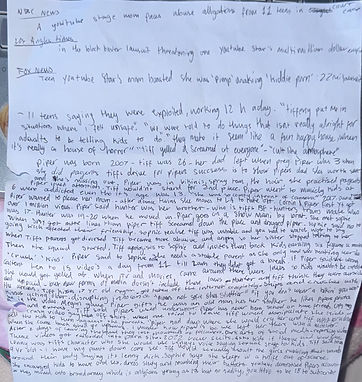.jpeg)
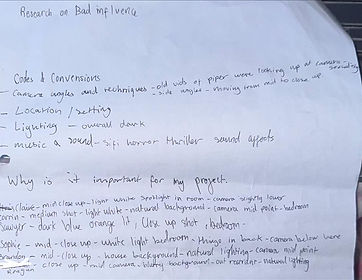
These are the notes I made throughout the documentary. This includes the information in the first half, and the codes and conventions of the next.
.jpeg)
.jpeg)
.jpeg)
.jpeg)
.jpeg)
Codes and Conventions
Camera angles and techniques
Because this documentary were videos of YouTube clips, I decided to write about the camera techniques when the guests are speaking. Some older videos of Piper shown, had inappropriate gestors like looking up at the camera, when a child does movements with the camera, lots of old men crave that and it will become sexualised.
When the shots are taken of the guests speaking, the camera angles move back and forth, then to the side. This gives us a sense of horror like when something traumatic is said the camera focuses closely on their face; making the audience listen and be more aware of what they're saying.
Claire's main shot was a mid close-up shot in a bedroom. The camera is facing slightly lower than she is, this gives the impression she's on-top of the audience, and we should listen to her because she knows what she's speaking about. It makes the audience believe her.
Corrin's shot is at medium shot of her sitting on a bad, the camera faces mid on with her eyes making her appear serious and connecting eye-contact with the audience. Corrin is one of the only members that kept eye contact with the camera.
Sawyer's camera shot was a close-up shot that had the camera level on with his face, but he didn't look at the camera.
Sophie's was a mid-close up shot with the camera below her making her seem bigger than the audience; this will make the audience trust her and agree with what she's saying, Sophie is one of the main stars in the documentary.
Brandon's shot was a mid close up with a camera mid point with his face, Brandon talks a lot about the story as a CEO of the company not as a member of the squad. Because of this he's facing the camera straight on giving the effect of him talking to us, teaching us about the scene but were made to trust what he says.
Reagan had two different shots, one he was in a restaurant the other in a bedroom, the first shot was a close up the second was a medium shot. When his shot was close up it seems more serious and when he will speak about traumatic, or scary scenarios the camera was close to him, the further back the camera was the less serious the information was.
I was going to use screenshots of the ex-squad members, for the camera skills, and them talking, but unfortunately the Netflix documentary, but you can't take photos, as the app wont allow me to use the photos. The screenshot image is black with no picture.
.jpeg)
Location/ setting
The Location of the documentary wasn't a set place, all the interviewees were in their own home/ space. I think they did this because they want to be in a comfort space but also by being in a comfortable setting like the audience, it can make the audience become a part of their show and while the audience can connect with the scenery, it makes them understand and believe the information being said.
Claire is in a bedroom by her vanity with sitting up straight, the background is blurry to hide and blend in the background so the audience aren't distracted by the back
Corrin is in her bedroom, cross legged on her bed, her bed is light but not many objects, this takes away the comfort feeling she has.
Sawyer was in his bedroom with lots of things around; when there was a close shot all his background was blurred. Sawyers room was very dark and gave the audience a sense of mystery.
Sophie was also sitting on her bed but had loads of mess and clothes in the background, this was slightly blurred out, but because of this mess it can give the audience an idea that Sophie has poor mental health which could be based by this social media incident.
Brandon was in a house being in one of the main front rooms, the background was blurred and made to look very rich, business attire.
Reagan was first in what looked like a restaurant which was blurred in the back, there was a big open window. In the next shot he was in a house in the living room, this made him seem like it was a comfortable setting and the audience will view him as a person, not celebrity.
The parents and adults that were in the documentary all was in a living room whereas the kids were in their bedroom. This senses that the kids are sensitive to this topic so they have to stay in their comfort place which is in their safe space. Whereas the adults are seen as more intellectual and are trying to share information that needs to be taking seriously.
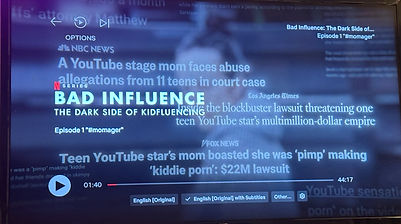_edited.jpg)
Lighting
Lighting was tricky, because I can only use when they were speaking as the rest were videos from the internet. Overall the lighting was dark, gloomy and depressing. When the children or adults spoke their setting was light and bright but when other videos start playing it's got a dark aura around it all.
Claire is in a natural lit up room with white spotlights from behind the camera , and her lit up vanity.
Corrin's lighting was white and light, there's lots of natural lighting from the window.
Sawyer's room was dark with blue lighting and orange spotlights making the scenario look like the podcast https://www.youtube.com/watch?v=pZSscDg6H1s. By the host Chris' setup in the back.
Sophie had a light white natural background with white spotlights in the back, but appeared to be slightly shadowed and darked by the lights, this is because Sophie wants the audience to connect with her and feel sad/ depressed with the way she expresses herself on the documentary.
Brandon, was in a white and yellow light background in a big natural lit room, this gives the audience a reflect that he's in a mansion and he has lots of money; which can make the audience weary of him but trust and understand him because he's seen as having more.
Reagan was in a slightly darker room with yellow home lights; his rooms weren't as bright as the others which may indicate a different view or past experience with the situation. The audience may come across as more understanding as the room feels more on edge.
The parents and other speakers were all in a white spotlight and natural lighting room with bright colours around to make the audience feel like they're in a cleaner, safer environment that can be trusted in.
Music and sound
There were lots of different music clips throughout the documentary, the sounds were sci-fi like, horror and thriller. I looked at multiple websites and searched multiple things, but no results for the music and sound effects came up. This is disappointing for my project because understanding different music choices is helpful to get me started on picking the music for my podcast.
Why Bad Influence is relevant to my project
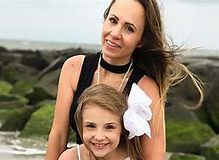.jpeg)
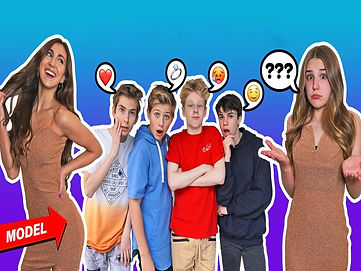
Bad influence highlights the importance of kids safety on social media. It indicates the real problems and the issues that are caused when children have fame and money in their hands. This dark thrilling story represents how a lot of the media reflects on children. Sexually, emotionally, verbally and physically. The way these kids were treated was disgusting and for other kids growing up on these apps having similar experiences. My podcast is about helping these kids through the dark side of social media and discovering shocking cases like this really makes my audience a target from older adults, predators and haters online. This documentary shows the struggles that thousands of social media stars go through and for my project I want my audience to be protected, understand these harms and steer away from them; so my audience understanding this is helpful because I can reflect how to not be stuck in a similar situation. When my audience use the tools I will share, to get them out of the harm on social media, they can understand what's right or wrong and what they need to leave behind. Overall this is important for my project because it highlights the damage of social media and unravels the dark truth hidden within the apps and guidelines. A documentary like this can promote business' into creating more guidelines and safety features to help adolescences'. This documentary also reveals different forms of social media, like BrandArmy, which is shocking, but it's so hidden that no one really knows about it. This documentary portrays the dark disgusting truth of the web and how brainwashing it can become. My podcast will give out that same thrill like atmosphere in order to protect children and show them the evil in order to prove to them how you can be safe.
History of social media
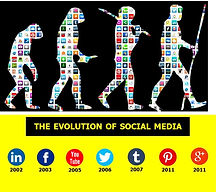
The Evolution of Social Media: How Did It Begin, and Where Could It Go Next? | Maryville Online
This website states the timeline of when the first 'social media' began. It's stated that in May 24,
1844, there was a series of electronic dots and dashes tapped out by hand on a telegraph machine created; this is the morse code that we know today as 'OMG', or 'LOL' and much more.
The next media out was in 1969, this was called Advanced Research Projects Agency Network (ARPANET). This was found in the USA that helped certain scientists share software, hardware, and other data.
In 1987 the National Science Foundation came around but after that they made a more direct nationwide digital network now known as NSFNET. This website now: Birth of the Commercial Internet - NSF Impacts | NSF - National Science Foundation
A decade later in 1997, the first social media came properly introduced called 'six Degress' unfortunately this shut down in 2001.
2002 an app called 'Friendster' came around. I used the website: What Happened To Friendster? 4 Reasons Why It Failed to help me understands this app. This app is essentially like Facebook. You could join groups with people based on your interests, message your friends, there was a variety of activities, like playing games or voting on different topics. You could Set up your very own profile, noting your interests, key facts, and background; this app only allowed 18+ to use. > personally I think this is so beneficial as it separates the idea of kids being hurt by older adults. This also protected the harm that minors may be getting exposed to. This app was taken over by myspace and Facebook, and was shut down June 2015. I think every social media app should be 18+.
2002/3 was also the year LinkedIn was launched, skype and Myspace. Myspace is similar to Facebook and similar with LinkedIn, LinkedIn has taken over longest lasting social media platform.
In 2004 Facebook came about.
Moving onto 2006 where twitter became known.
Etsy was also in its beginning stages and didn’t reach a million dollars in sales until 2007. The company went public in 2015 and continues to be the premier place for sales online. Information from You Won’t Believe What Was Popular on the Internet 10 Years Ago - Brit + Co also stated that in..
2007 is when myspace became the most visited social media site in the world. This site was more popular than google; celebrities like Taylor Swift and Kim Kardashian dominated Myspace.
Unfortunately for myspace, in 2008, Facebook overtook that name and became most visited site in the word; this knocked Myspace down to the bottom of the social network list.
In 2010 Meta created Instagram. In 2010 everyone was using mobile apps and the first iPad appeared; by the end of 2010, Instagram had over a million users and Facebook had over 5 million. Youtubers, vloggers and influencers started rising up and becoming more of a thing. This was founded by What the Internet Was Like in 2010 | Cybercultural.
2011 is when snapchat got published.
Nothing really happened until 2014 when musically was published and all the content creators went to this. Learn from the story of Friendster, what happened to Friendster, its downfall and lessons from its failure story This website explained that in 2015 Friendster services shut down, it as stated that it shut down because they didn't want to compete with Facebook.
2017 is when TikTok made its appearance; which led musically to shut down in 2018 moving all users onto TikTok. This all happened because Byte Dance merged these apps together.
In 2019 Google + shuts down and in 2020 clubhouse joins; TikTok now gets moved to the most downloaded app in the world.
In 2022, it was stated that over 4.7 Billion world wide users were on social media; this means its gone up; the website Global social media statistics research summary 2022 - Sinfras helped me to realise over half the world are now on social media and has risen with 4 million new users since 2020-2021.
In 2023 Facebooks meta decides to merge with the creator studios with business suite, they also started creating Ai.
In 2024, BeReal came out and twitter became X because Elon musk took over,
My audience will benefit from this because I want to find out where everything started in order for me to figure out the link between social media and mental health. Because Jonathan Haidt said there's a resemblance I want to add a little timeline on everything that's been included. This is good for my audience because they can see where the issues erupted from. Overall this is helpful towards my project and podcast because I want to give my audience valid responses with the idea of mental health and social media being on similar timelines; my audience can take away a lot from seeing this timeline, such as noticing when certain apps started and where the inspiration comes from. Because of this we can also look at crime rate and see if the years match up with each other. If it does then my audience can understand the links and will understand more on where mental health was evolved.
I used the website Global social media statistics research summary 2022 - Sinfras
To find out the target audiences over the time period. The website explained that in 2021 400 million new users have joined social media since 2019-2020. I then found this graph from https://electronicsvsgender.weebly.com/data.html that showed the usage of social media from 2006-2014, and their ages. The ages is what I'm focusing on.
This graph states that in 2006 it was extremely common between 18-29, at this
point not many teenagers under 18 can have social media due to its age limits.
At this point there was no 65+ on social media. 18-29 year olds were at the
highest rate up until 2014 when ages 30-49 started to join and reach the same,
they then dropped back down again throughout that year. This graph is so
helpful to my project because working out the age barrier throughout the years
really inflects onto my project and my target audience. My audience will need
to understand the importance of why I'm doing this project- to help keep
people safe online. And to do that I need to find information on the past ages
that used social media years ago, by doing this I can determine if it's the still/
always has been the same or if something happened down the line that's
causing kids now to act differently.
The next graph I found was from https://www.pewresearch.org/internet/chart/social-media-use-by-gender/
This graph showed the different usage of social media between male and females over the years.
In 2006 we can see its mostly men who use social media, this only started to
change in 2008 when women and men were equally on social media, women
then shot up slightly (around 5%) just after 2008 and went up (around 10%) by
the time 2009/2010 came. Both genders rose up men around 10-15% and women
20-25%, by the year 2011 men dropped by around 5% and women shot up 5%, men
increased again and didn't drop until 2013, in 2012 women dropped down being
the same level as men but shot up 20% by 2013.
In 2014 both genders just slowly increased over the years; women still staying an
extra 5% more until men dropped by 5% in 2016 whereas women kept increasing,
moving women up by 10% more. Overall I got information on gender audience's
which is helpful to my podcast because I can determine who my gender target
audiences would be by discovering what they were in the past. This also ties into
my research into what gender will most likely be exposed to harm or hate, which
means who's mental health will be effected more, because my target audience is
important so by understanding different audiences over the years helps me find
mine.
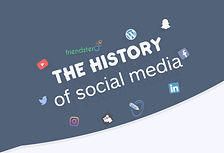
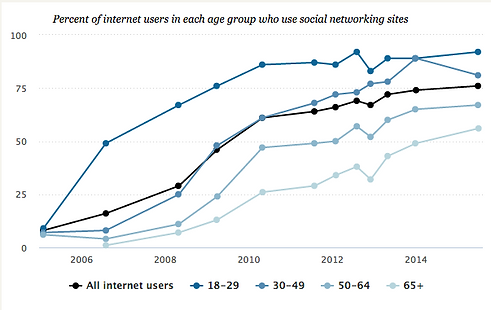
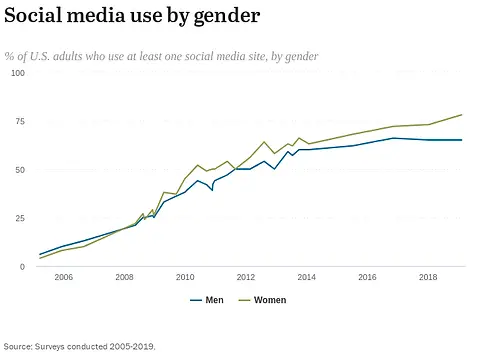
Future of social media
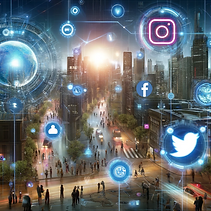
This was a lot harder to research about because there isn't much information on anything. I looked at loads of sites but only 10% of them had valid information. Because this was difficult I had to try look up the titles of my contextual research mind map. My weaknesses started out as being research as I wasn't very good; but over the research I've been doing for this project I feel I have improved. This time I got stuck though, I understand where my weakness are and so I thought of ways around it and thanks to my mind maps I did I was able to stay on track. I earned skills throughout this research planning and I have improved on my weaknesses.
I looked into a website The Future of Social Media (2024-2027).
This website stated that we're expecting 5.85 billion users will be on social media by 2027. The future of social media will be difficult to research into because our world is moving to rapidly with technology we can't tell what's going to come next.
From a website Here’s How the Internet Will Look Like in 2050.
I found that apparently in 2050 social media platforms such as Facebook, will transform into massive virtual spaces where you can connect with friends and communities as if you’re in the same room. You’ll join events, play games, and engage in various activities with just a touch or even a thought.
The link 10 grand challenges we'll face by 2050 - BBC Future helped me process what could be happening, and discover if this would be good or bad for our world. This website stated that we will have no privacy; everything will be on the internet with even worse cyberbullying, it's stated that we will have far many new problems with social media to solve, Facebook is only 13 years old. China are coming out with robots. So the link with social media and AI will be scary.
The website What will social look like in the next 10 years? - We Are Social UK
Stated that by 2028, website made in 2018, we will see Ai more like a human rather than on a screen. I think this is quiet scary and a lot of my audience might feel the same, therefore gaining this information is perfect for trying to change the guidelines and keeping my audience safe (the world moves rapidly, so we have to think ahead), but also my audience would be interested by the Ai future and can gain knowledge for themselves and stay more aware.
So how can we change this?
The most important thing to do in my opinion, is to educate everyone on what the social world will actually be like, we have theories, stories and movies but no real data facts. But when we get some real answers we can plan our next steps. Let's say social media and Ai became everything, you are your online persona. Everything about you is one click of a button. Well what do we do? We try to figure out a way that we can protect this; what I would do is set most of socials to private; talk about getting kids a different form of guidelines or social media, then I would keep track of my time spent on or off; this way I don't lose track of time and staying on a phone all day, lastly I would set tasks to do throughout the day so I wouldn't get the urge to go on my phone.
My audience can benefit from this because they can adapt to the world around them, they will remain safe and not ruin their mental health. This is so inspiring for my project because the aim is to create a podcast that helps others feel safe online and to know the ways to be safe; so understanding what's happening in the world for the future, my audience and I can start preparing faster, keeping ourselves away from harm.
Bill Ready: why social media turned toxic and how we can fix it,
This website stated that they feel as though Ai will help these social medias by enhancing skills onto Pinterest with outfits, or the idea that Ai will help detect what's making people depressed. This is helpful to think about be it projects light on Ai in the good side, my audience will benefit from this because they can learn what good to expect rather than just being scared about what's to come. They did also mention how no good does anyone who sits at a phone all day. This is a point a lot of the podcasters spoke about.

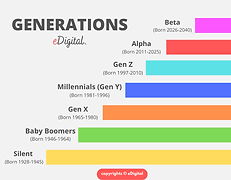
Who's affected?
The ones affected by these issues are the up coming younger generations. GenZ are slightly in that age barrier as they grew up with phones but not so much to the point we had didn't have a play-based childhood. But they would still be classed as one of the affected generations. Social media came out when we were around pre-teens or primary school. We also didn't grow up with Ai, but now the technology in the world is changing so fast we cant stop it. We have to save ourselves from being harmed by these apps and for the younger generations that's difficult to see when you've grown up with the social world in the social world.
It’s Causing Them to Drop Out of Life’: How Phones Warped Gen Z - POLITICO
This website stated Jonathan Haidts book and how GenZ are the anxious generation, how social media warped their brains and how this generation has the worst mental health.
This website also stated when Jonathan Haidt spoke about how teen mental health has dramatically worsened after the iPhone, and Instagram was created. He blames Instagram for causing the most initial damage of the new generation particularly in declining mental health for girl but he announces another threat. “TikTok is arguably the worst consumer product ever invented,” this shows that the younger generation are more affected and it's causing an increase in mental health.
The Impact of Social Media on Gen Z Mental Health | DISA
This website stated that when COVID19 was around in 2020-2021 GenZ mental health started declining. Anyone born between 1997 and 2012, who have grown up immersed in the digital world. Anyone after 2012 grew up with Ai being their "best friend". those born before had a relatively good play-based childhood.
I used the site Negative impact of social media affects girls and boys at different ages – study | University of Oxford.
Which I used to determine what gender is more effected. The site told me that girls are more prone to social media at 11-13, whereas boys are more prone to social medias harm at 14-16. The next website I used is How Social Media May Harm Boys and Girls Differently | Psychology Today.
This stated the different examples of why Girls or Boys are more effected. The first example is Girls are more invested in social media than boys are, on average. The reasoning behind this is if a boy posted something and someone didn't like it, he most likely wont care; but a girl would care if someone didn't like their post. The second example is that Boys post a wider range of their lived experience; girls' postings are (on average) more curated and more polished. Their reason behind this is because if both a girl and a boy threw up, a boy would more likely post it and another guy wouldn't want to be like that. Whereas the girl, she wouldn't post it; but girls will look at another girls post and wish that was her. The last example is about Boys often overestimate how interesting their own lives are to other people. Whereas a girl will always think someone else is having more fun than she is.
Some facts from the website How Does Social Media Affect Gender Identity – Openr explains that these are certain examples of why social media is different for both genders.
-
Men are more likely to use social media to seek information.
-
Women use social platforms to connect with people.
-
When men do open social media accounts to network, they’re more often looking to form new relationships.
-
Women are more focused on sustaining existing relationships.
How Social Media Affects Genders Differently - M-A Chronicle
This website stated a survey that lots of teens were submitted to fill out; the majority said that girls are more prone to harm as the have to live up to the expectation to 'fit in', or to look and act a certain was to be classed as good.
Overall we can tell that Social media effects GenZ and younger; and will have more of an effect on women due to jealousy or unstable self-identity. Another important factor of doing this is to figure out who will more likely be affected, so who will more likely be my audience. My audience will benefit from this because I will learn who's most affected so I can focus on helping them in my project and podcast. My podcast will consume of helping those remain safe on these apps; and by understanding who is affected I can work out how to help get around this.
Therefore my audience will benefit from this because understanding the people affected by social media will help me understand my audience which leads my project to be educational but also understanding. This will attract more types of audiences and more of my podcast and project will be seen.
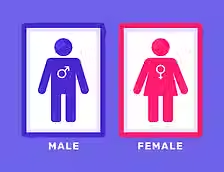
Treatment and Risk Assessment
My Risk assessment wouldn't upload properly while trying to send it off. I think this is because I wrote down my risk assessment after I booked my equipment; so the app wouldn't let me select any items that I didn't have booked. I decided to say these items were mine and explain I loaned the items from college, but then I had to upload a document of proof or something; I will speak with my tutors when I get into college to figure out what's happened. I decided to take screenshot's and upload them to my website instead. When I sort out the document I will add that as well.
This first section is about the activity, my activity was to do a podcast. I also had to write down the date of equipment collection which was on Tuesday 29th April, but unfortunately by the date of doing this it wouldn't let me upload the date so this got left blank. Underneath this was a section about your supervisors name which is my tutor Grahame Gladin; the last part is about adding a detailed description of your activity. For this I spoke about a podcast filmed in radio studio 1, about the harms of social media has on your mental health. I am bringing in a guest from outside the college.
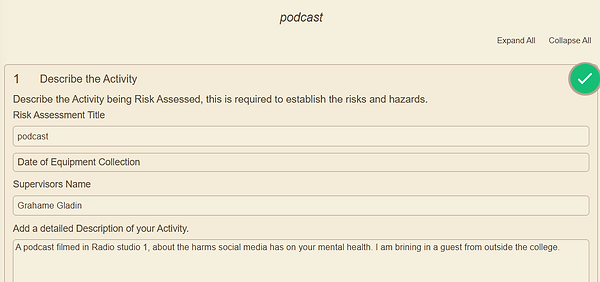
This section is about the people at risk. This is important because I need to speak about who's possible for being harmed. For this I needed to write down the name of the primary risk assessment holder. This is the media tutors; next they asked for contact information which I put as staff. Then it moves onto the people at risk, the group they are, their role and contact number. I started off with myself, being a cast, host and 00051885@nkc.ac.uk. The next person is Johanna, who's a cast, guest speaker and her contact number is 07920504762. The final person is Lorca who is the crew, camera woman and her contact number is 0004851@nkc.ac.uk
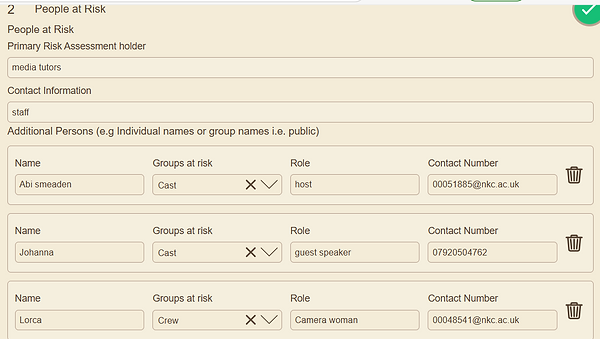
Now this section is the one that made it unavailable to send it off and create a link. What happened is when it asked for the equipment from the college it asked for my booking, because my equipment wasn't booked at the time of doing my risk assesment it didn't work so I had to say that I used my own equipment and then mention that I loaned it from college and safely in a cupboard or the radio studio for the RODE mic and stand. The next equipment are two canon cameras 750D and a canon camera 850D, the next items were two flo light micro beam 1024. This section is important because we need to male sure nothing was lost or broken. By recording what we had, when and where it will be and where we'll put it back is crucial for my project so I am on track of what I'm using. I used these items on Tuesday 29th April and I handed them back in on the same day.
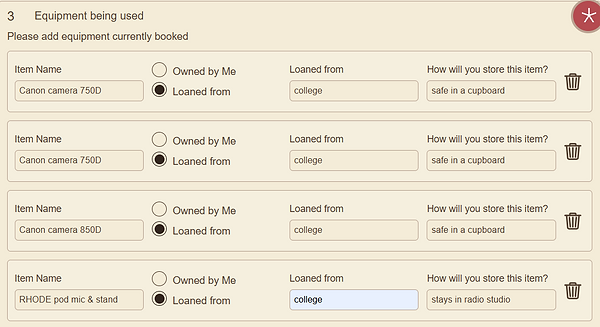
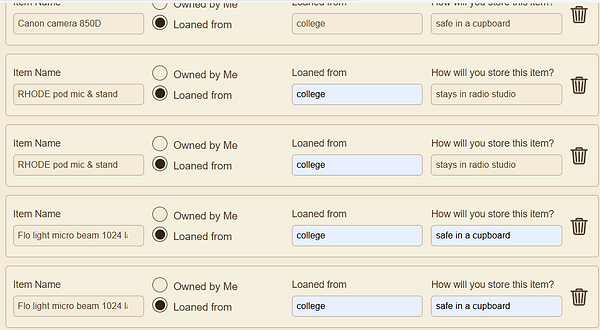
The forth section is about location. Both the guest and I will be in the college on Tuesday 29th April. The location of college is Oakfield Lane, Dartford DA1 2JT. I wrote my name Abigail Smeaden first and Johanna as second.
The fifth section is about Emergency procedures, in this section is where I recorded the first aider who I put down my tutor Grahame, I wrote down his contact details which is his email; GrahameGladin@nkc.ac.uk. The next part is about the Nearest hospital which is Dartford hospital, their contact details 01322428100, the next part is about the nearest police station. For this I put Dartford police station; their contact number is 01622690690. This section is important because I need to understand where to go if there is any harms.
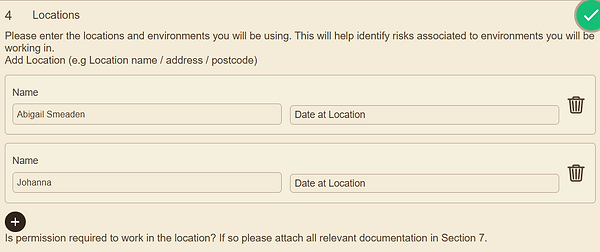
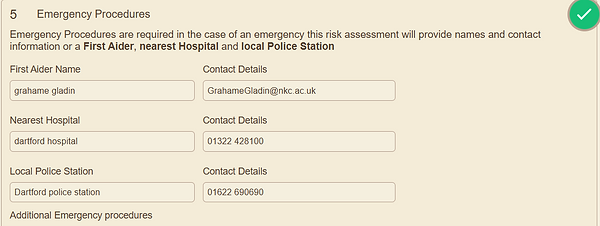
This section is the one about the harms and activities. The first activity was having a glass or mug. I put this down as the guest and I both had cups, this is a moderate risk because it could smash leaving broken China that can cause cuts on wires or people. For action I wrote about making sure the cups aren't by the edge of the table. The next action is about being in a confined space, this can be dangerous because the lights and cameras/ tripods are slightly big for the room when there is a table as well. Because the studio is smaller than normal rooms with that amount of equipment, I noted this as a tolerable risk, because the small space is more prone to tripping or knocking over. The next activity is about cables and equipment, this is put as a moderate risk because there's a chance of tripping which could harm the person or damage the equipment. The action for this would be to tape down all the cables and be safe; I didn't tape down my cables which I will note down to do in future; but I was remaining safe around the cables. My next activity is slipping tripping and falling, because we are in a smaller space, with liquid, lots of equipment and cables around, this could cause a moderate risk to the setting and the person. Remember to walk and move with caution among the set. The last activity is about working around water. This is a moderate risk because there is a risk of the water spilling on the cables, laptop, papers or make someone slip. The action to take is to remove water away from anywhere it could cause potential harm.
This is the last section where it asks to upload a doc of proof that I had the equipment from home (section 3). The warning from this said "you have missing information required: equipment being used bookings.
The final part is about approval; request approval, select an approval lecturer I chose my tutor Grahame Gladin. I also ticked off the terms and conditions.
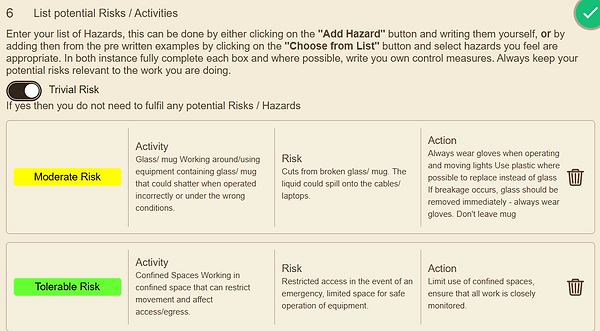
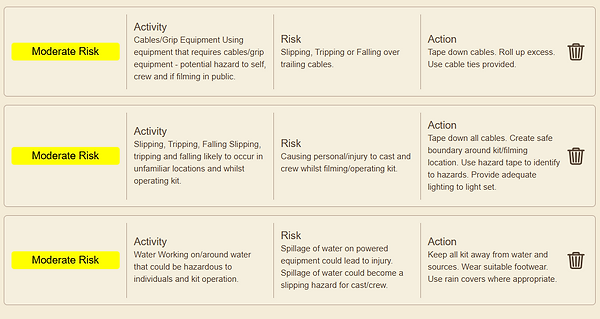
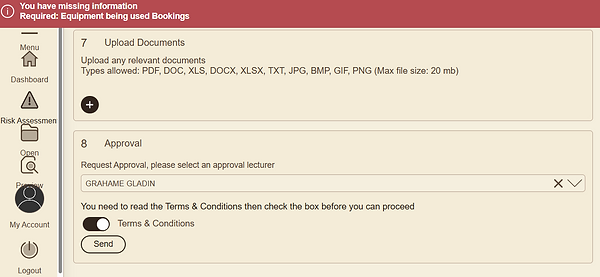
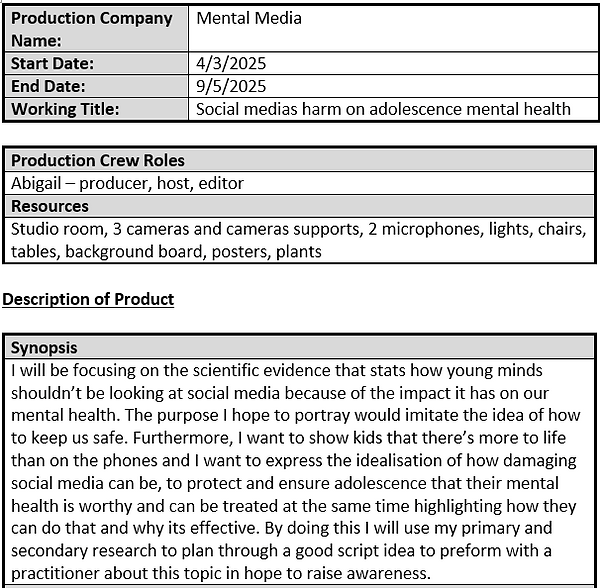
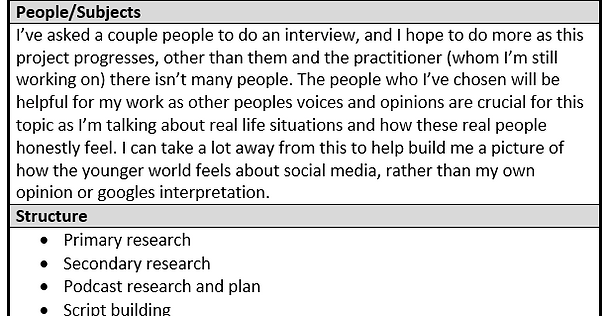
This is my treatment, my treatment is an important part of my production as it explains in detail what I want my podcast to look, format and be like. I want to be clear on my answers and how I got there. Some things did change after I wrote this. I was confused at first what some of the titles meant. I asked my peers for some help understanding. I believe I covered some of my treatment but haven't made it 100% accurate; because I could've read over this before I did my podcast. Overall I have developed skills in treatment understanding and I have new targets of making sure I follow my treatment and keep double checking everything is correct, and the same.
